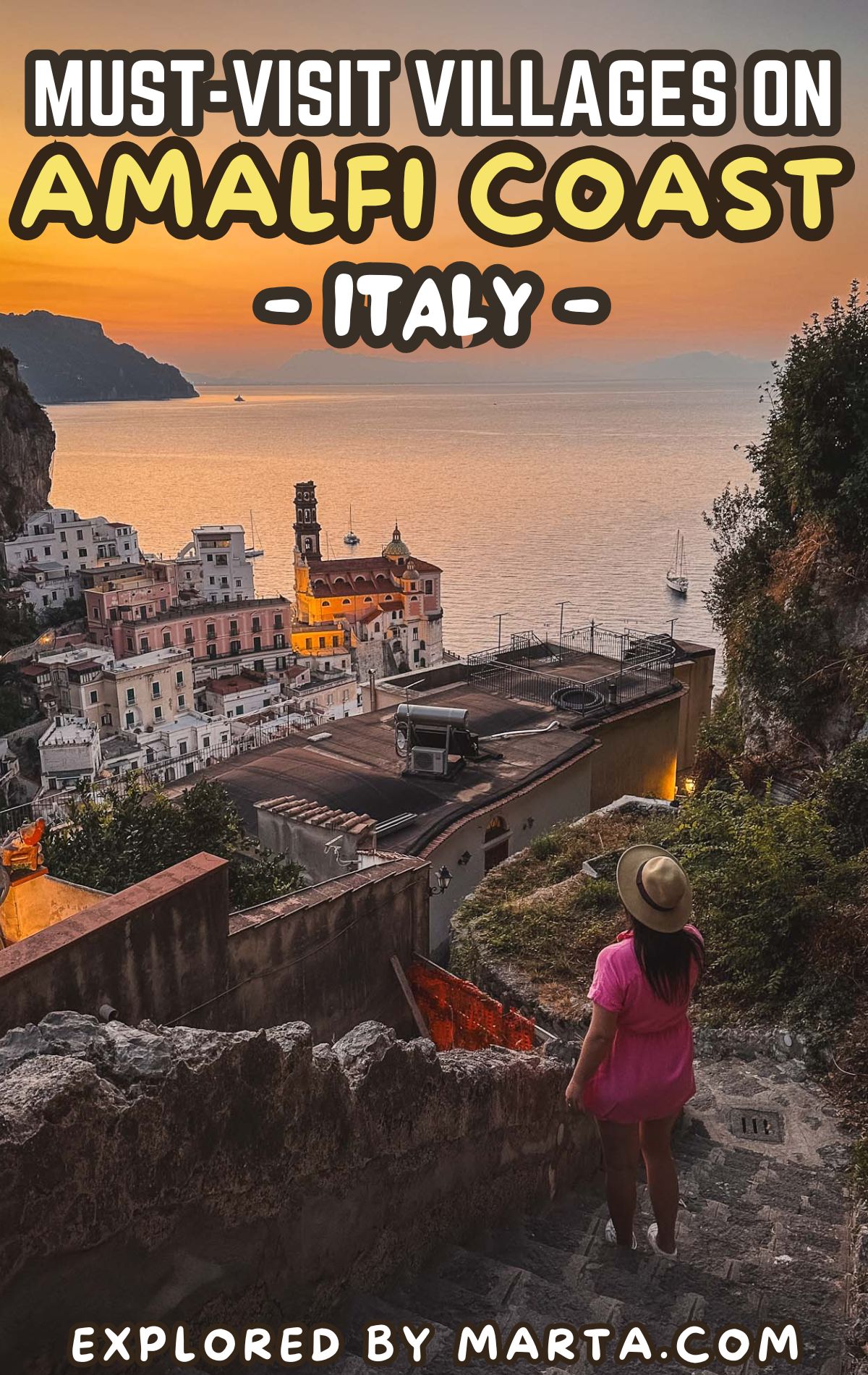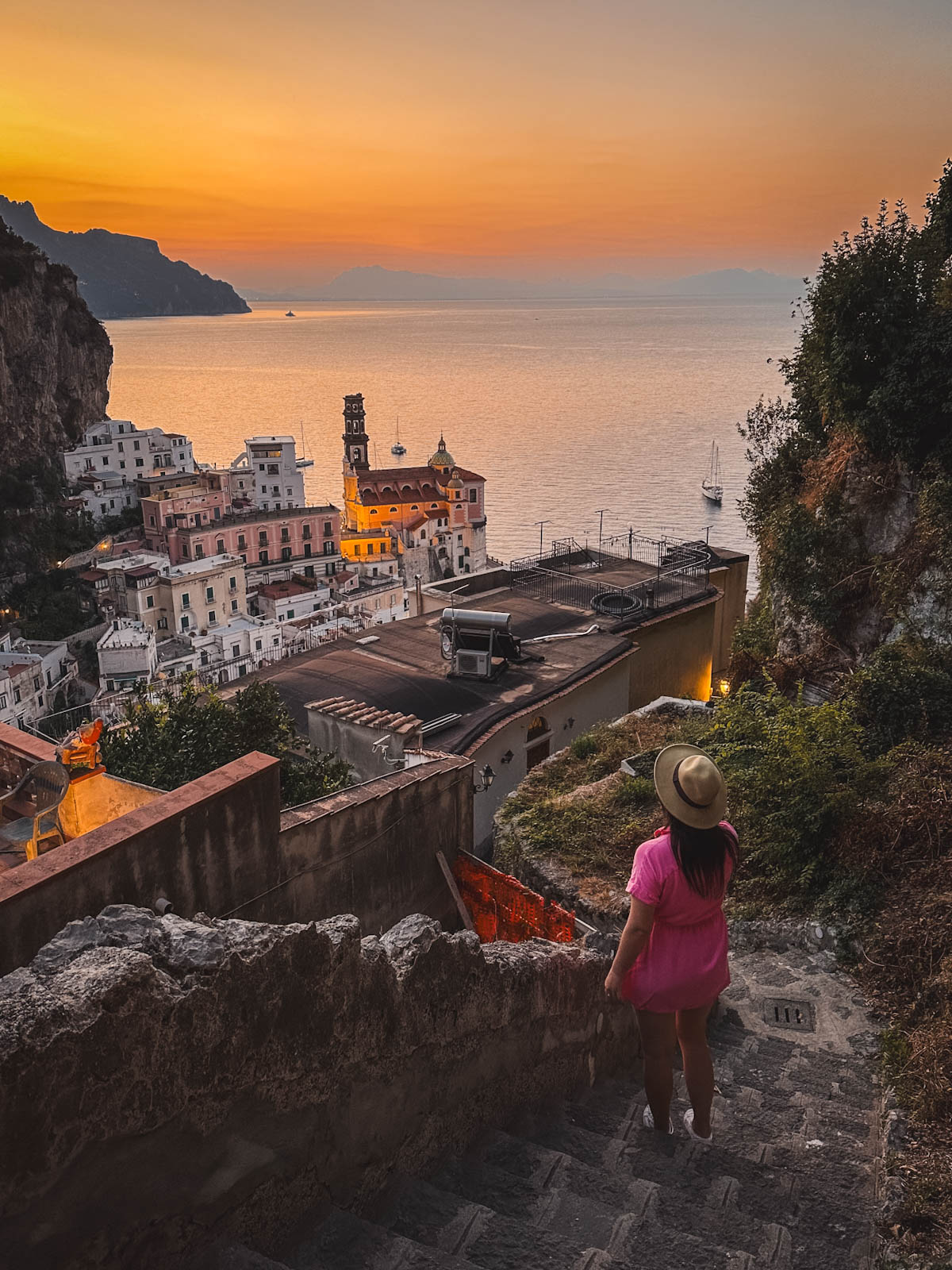Guide to 10 must-visit villages on the Amalfi Coast, Italy
This post may contain affiliate links. If you use these links to buy something I may earn a small commission at no extra cost to you! Thank you for your support!
Are you planning a trip to Southern Italy and are curious to know which are the most beautiful, must-visit towns and villages on the Amalfi Coast? I’ve got you covered.
Famous for its stunning nature, cliffside villas, panoramic views, and charming villages, the Amalfi Coast is a place like no other. We spent around six months living in this part of Italy, and visited nearly every place on the map.
The Amalfi Coast is home to 13 main villages or municipalities: Positano, Praiano, Furore, Conca dei Marini, Amalfi, Atrani, Scala, Ravello, Minori, Tramonti, Maiori, Cetara, and Vietri sul Mare. Not all of them are *actually* worth a visit, so here is my Top 10.
In this blog post, you’ll find all the most beautiful villages on the Amalfi Coast with photos, descriptions, and locations on Google Maps. Happy travels!
1. Amalfi, namesake town of the Amalfi Coast
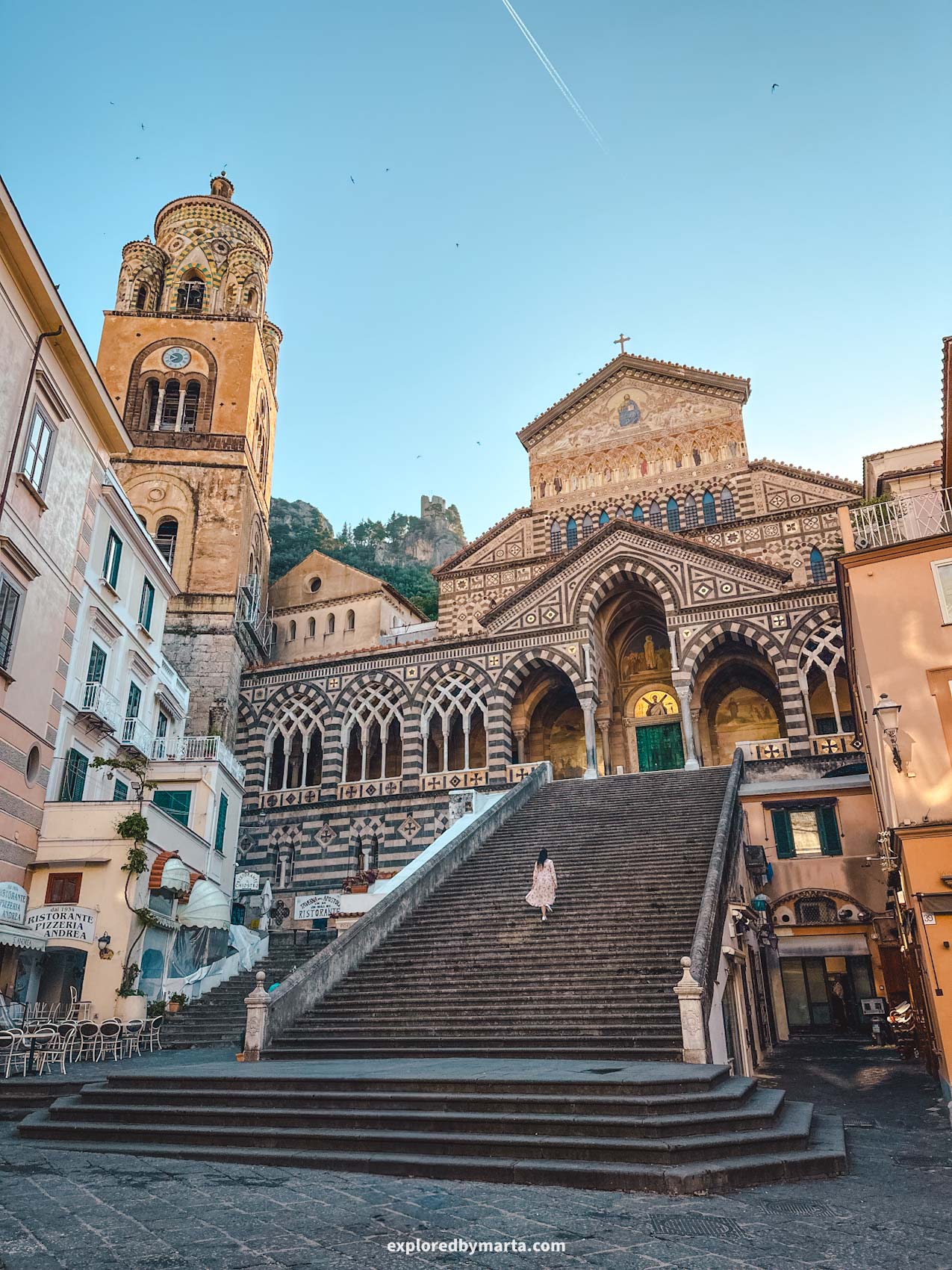

Visiting the town of Amalfi on the Amalfi Coast sounds like a no-brainer, and it is exactly that. Placed right in the center of the whole famous coastline, Amalfi attracts visitors with its Medieval charm and scenic views.
Back in the 10th-11th centuries, Amalfi was a well-known maritime republic known as the Duchy of Amalfi. Despite its small size, the Amalfi Republic was highly advanced when it came to navigating the sea and was known for its skilled sailors and naval experts.


Today, the town of a population of a couple of thousand people attracts visitors to its famous attractions like the Amalfi Cathedral, the Paper Museum, the Cloister of Paradise, and its seaside promenade stretching along the gray-sand beach.
Amalfi is also perfect for nature lovers who prefer to skip the crowded, narrow streets and piazzas. A gorgeous hiking trail goes up in the mountains to Valle delle Ferriere valley, passing ruins of ancient mills and multiple waterfalls.
It was one of my favorite hikes on the Amalfi Coast!

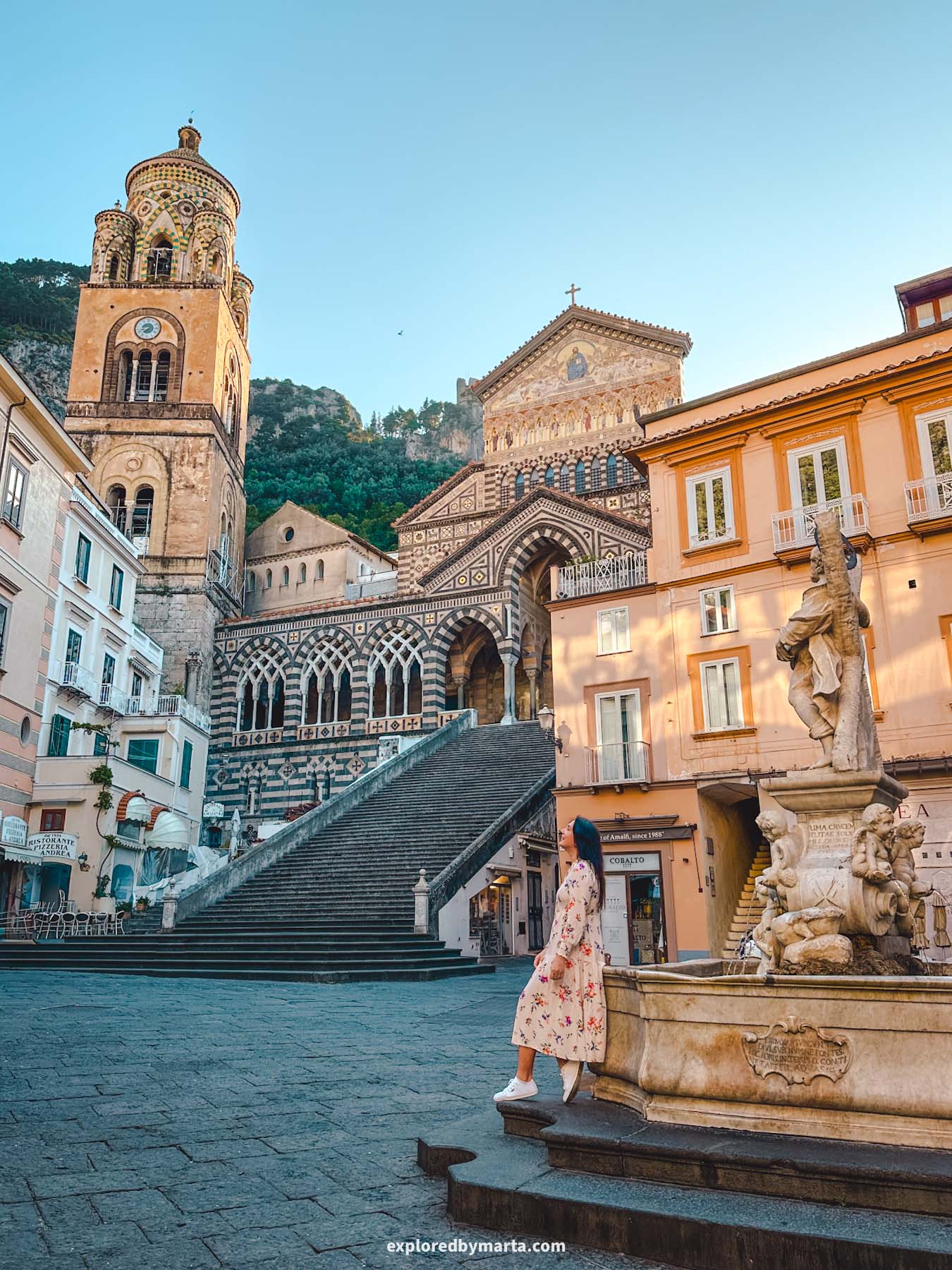
Amalfi is also the perfect place to stay and use as a base for travels around the Amalfi Coast. Amalfi is very well connected to all other villages on the Amalfi Coast. You can get everywhere by hopping on the SITA SUD public bus or jumping in one of the little ferries.
For those visiting Amalfi by car, there is no better place to park your car than in an underground Luna Rossa parking carved inside a coastal rock and connected to the town by a pedestrian tunnel. Probably the best parking on the Amalfi Coast!


Amalfi is also a paradise for foodies. It offers a wide range of restaurants, snack bars, pizzerias, gelato shops, and more.
You must try the Delizia al Limone dessert, the sfogliatelle pastry, lemon sorbet inside a lemon, Cuoppo di Mare, and scialatielli pasta (pasta invented right here in Amalfi). All of them are must-try foods on the Amalfi Coast.


On the other hand, Amalfi is one of the most visited towns on the Amalfi Coast, and it gets busy during the day in high season (summertime). I recommend arriving here in the morning to soak up that Amalfi charm without the crowds.
If you are staying in Amalfi, I recommend walking to the nearby small town of Atrani. Amalfi and Atrani share a long history together and are often called ‘the twin towns’. You can walk there through a pedestrian tunnel in less than 10 minutes.
Why visit Atrani? Well, there’s a lot to love about this charming little town, so read along!
Location: Amalfi
2. Atrani, the smallest town in Italy

With a population of fewer than 1,000 inhabitants and an area of 0.12 square kilometers, Atrani is said to be the smallest town in Italy. Despite its proximity to the famous Amalfi, Atrani receives considerably fewer visitors and is still a hidden gem on the Amalfi Coast.
We spent multiple days exploring Atrani, and I can safely say that of all the villages on the Amalfi Coast, Atrani was by far my favorite place on the map.
Atrani is separated from Amalfi by a seaside mountain, and you can easily walk over there through a pedestrian tunnel carved into a rock.


Historically, Atrani played an especially important role during the 10th-11th centuries when this area was an independent state (the Duchy of Amalfi or the Republic of Amalfi). All the rulers (Dukes of Amalfi) were crowned right there in Atrani.
Today, Atrani is known for its dramatic landscape and postcard views. The tiny town was a filming location for Netflix’s series Ripley as well as The Equalizer 3, featuring Denzel Washington.
To be honest with you, I hadn’t seen any of these movies and series, but I watched all of them after my visit to Atrani just to have that ‘hey, I have been there’ moment while watching the movies.


There are many fun things to do in Atrani, but I would definitely enjoy the postcard view of the beach, climb the stairs of Chiesa di San Salvatore (this is where they crowned the Dukes!), and have lunch at a beachside restaurant Le Arcate or Le Palme.
Atrani is all about the views and enjoying that slower pace of life as compared to its hectic neighbour. I especially loved coming here in the morning before the streets fill up with locals.
We ate Pasticciotto atranese in the main square, climbed the stairs of the iconic Chiesa di San Salvatore church (this is where they crowned the Duke of Amalfi), and went to the beach while it was completely empty to have that postcard view all to ourselves.


Atrani is a great place to stay while exploring the Amalfi Coast. It is much quieter than Amalfi and might be a bit cheaper, too. But just as beautiful as Amalfi (and only a short walk from its famous neighbour!).
For those of you who are hikers, Atrani offers a couple of scenic routes to walk. Atrani is connected to Ravello village, which sits on a cliff right above Atrani, by a long staircase. If you are up for a challenge, this is a good option.
We also did a fantastic hike to the haunted Torre dello Ziro watchtower that sits atop Mount Aureo, one of the mountains next to the village. From there, you can see to both sides – on the left, you’ll see Atrani from above, but on the right is Amalfi.


But I’m not done yet. There’s a special experience to have for those who love exploring true hidden gems. Located high on a cliff above Atrani is a beautiful 12th-century sanctuary and secret caves that used to house a monastery.
These places are behind a gate, and you can’t visit them on your own, but you can visit them if you book an appointment online (I sent a DM on Instagram) a day before and arrange a tour with a local guide. The tour is free, but we gave him a tip.
He offered us a sunrise tour, so we came back to Atrani the next day before sunrise and climbed up to the sanctuary while it was dark. At first, we toured the two caves and then finished the tour at the sanctuary. One of the most beautiful spots on the coastline!
One of the caves had the shape of a heart, and this is where we waited for the sun to come up. It was pretty unforgettable. One of the most memorable experiences I had while traveling around the Amalfi Coast! I hope you get why I loved this village so much!
Location: Atrani
3. Ravello, the City of Music


Ravello is a romantic clifftop town on Italy’s Amalfi Coast, famous for its fairytale-like villas, Villa Cimbrone with its Terrace of Infinity, as well as Villa Rufolo with its gardens and coastline views.
Ravello is actually one of the oldest villages on the Amalfi Coast, as it was founded back in the 5th century as a place to escape the pirate attacks. Today, it is a popular tourist destination and a mandatory stop for visitors to the Amalfi Coast.
Ravello is nicknamed the City of Music and yearly hosts one of Italy’s oldest festivals – the Ravello Festival. It was created in honor of the composer Richard Wagner, who visited Ravello and found inspiration for his opera Parsifal in the Villa Rufolo.


Ravello hosts one famous place everyone should see before they die – the iconic Terrace of Infinity inside Villa Cimbrone. Gorgeous marble busts line the terrace along the cliffside and offer some of the best views of the Amalfi Coast.
Villa Cimbrone is also a paradise for photographers, hosting some of the most iconic photo spots on the Amalfi Coast right here!
Originally built back in the 11th century, Villa Cimbrone has lived a truly eventful life. Throughout its existence, it has been a residence for many different influential families until the 1970s, when it was turned into a luxury hotel.


You cannot tour the hotel unless you stay there as a guest, but the majority of the property is open to the public (for an entrance fee). As a visitor, you can visit a cloister, a temple, multiple beautiful gardens, and the famous Terrace of Infinity.
People like Jacqueline Kennedy, actor Denzel Washington, actress Greta Garbo, as well as Winston Churchill, some members of royalty, and even the surrealist artist Salvador Dalí have all visited this place.
It truly is a one-of-a-kind place to visit!
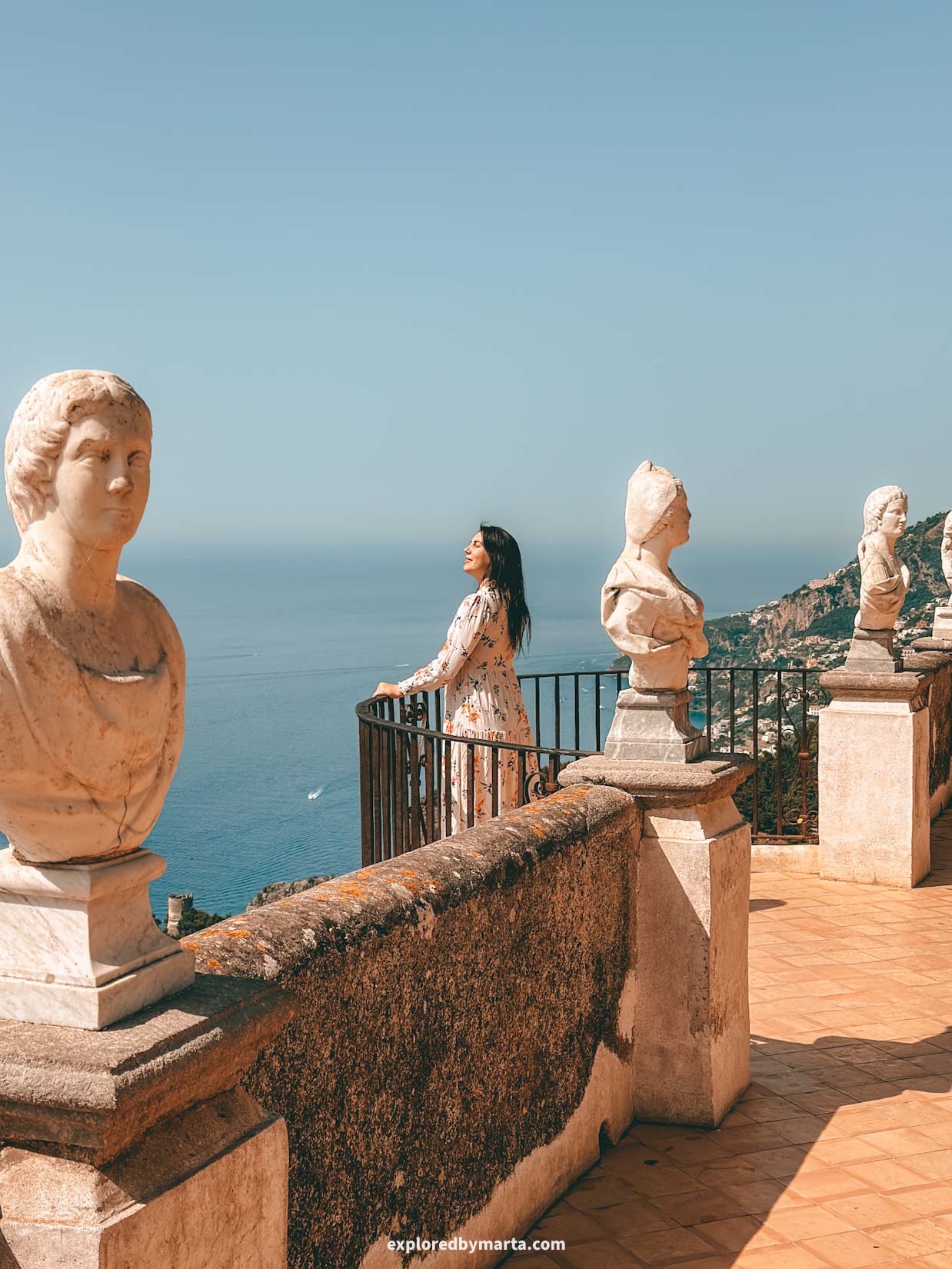

Other must-visit places in Ravello include Piazza Duomo, also called Piazza Centrale, with the 11th-century Duomo di Ravello in the middle, the bustling shopping street Via Roma full of handmade ceramics shops, as well as the modern Auditorium Oscar Niemeyer.
But the only place that can compete with the famous Villa Cimbrone in Ravello is Villa Rufolo.
Villa Rufolo is a vast 13th-century estate built by the wealthy Rufolo family, who were influential merchants in this area. Today, this estate is open to the public (for an entrance fee) and hosts different local events.


Villa Rufolo is one of the main sites for the famous Ravello Music Festival, which takes place every year during the summer months. Apart from that, it is known for its breathtaking postcard views of the Amalfi Coast!
We got to explore the vibrant terraced gardens with panoramic Amalfi Coast views, saw the cloister, and climbed the medieval Torre Maggiore tower. But there is one especially unique place in Villa Rufolo.
Located inside the gardens is a small viewpoint that overlooks an iconic view – the towers of the Church of Saint Mary of Grace, with an iconic pine tree and the scenic view of the Amalfi Coast in the background. A place to remember for sure!
Location: Villa Cimbrone in Ravello
4. Positano, the quintessential Italian town
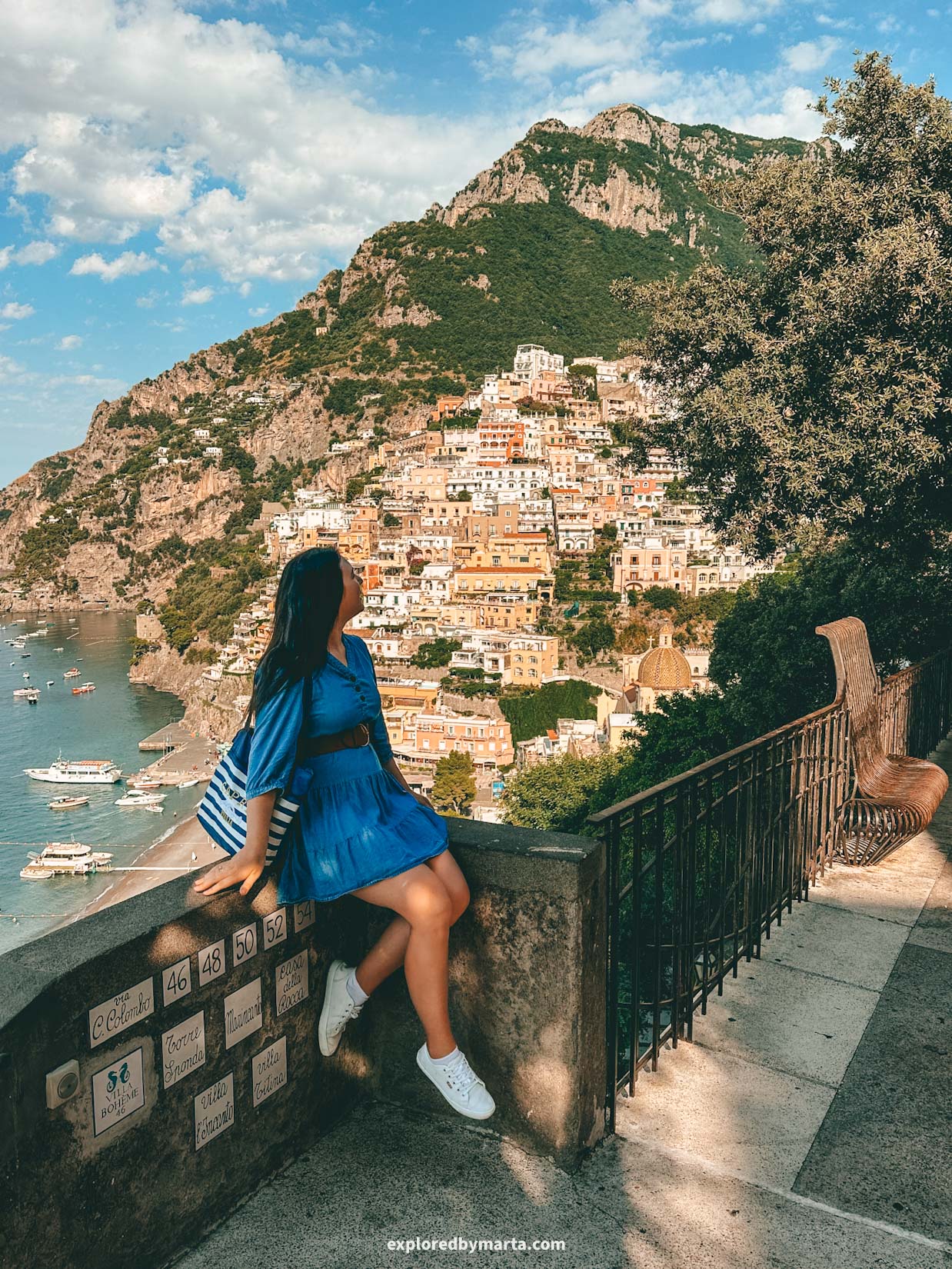
Hello, Positano, one of the most iconic destinations and picturesque towns in the world! If Amalfi is the historic heart of the coast, Positano is its glamorous face and must be on your Amalfi Coast bucket list!
With pastel-colored houses tumbling down steep cliffs, narrow staircases instead of streets, and boutiques on every corner, Positano feels like a real-life postcard come to life.
Originally a small fishing village, Positano gained international fame in the 1950s when celebrities and artists started flocking here. Since then, it’s become one of the most iconic destinations in Italy and the world.

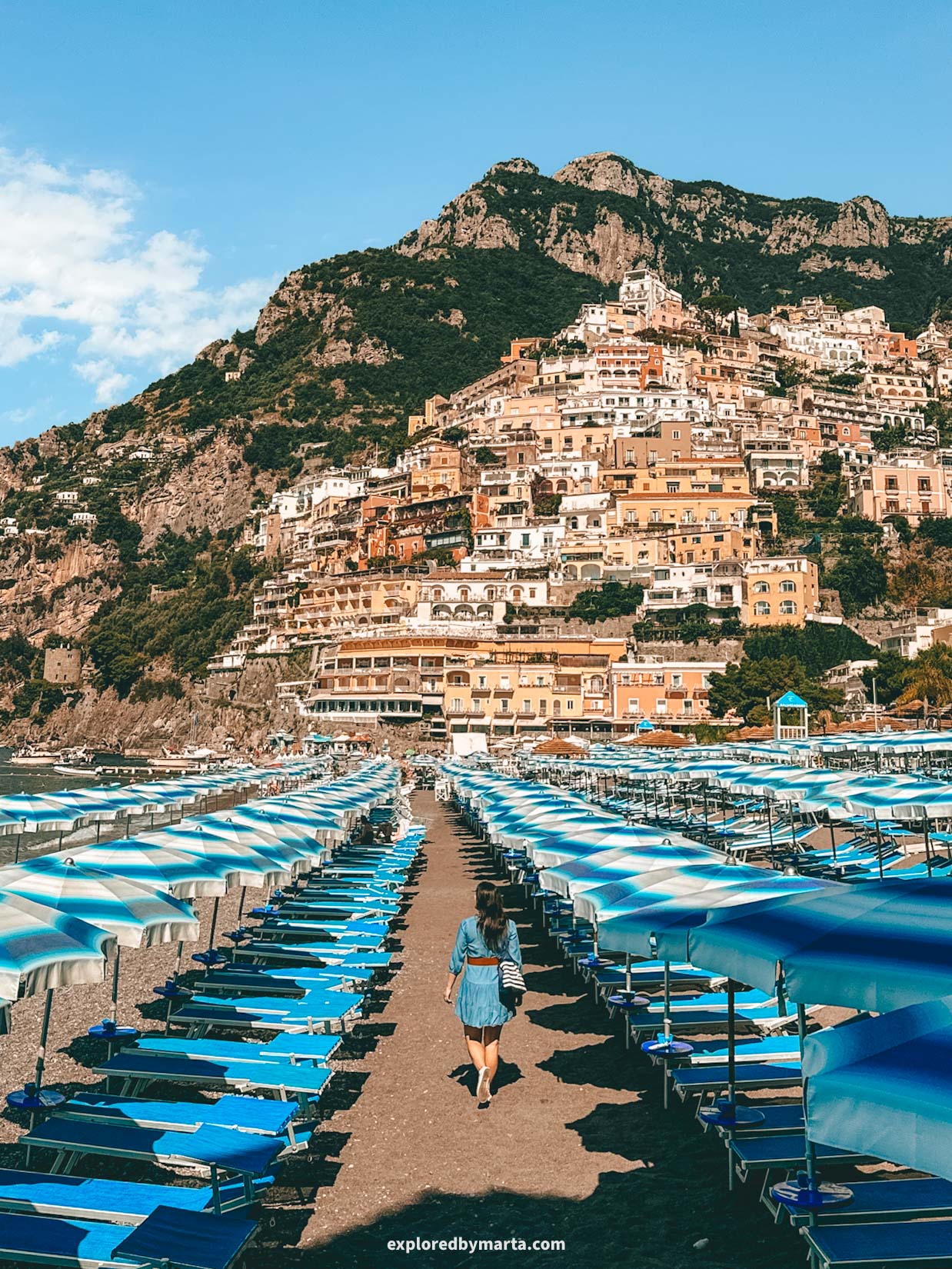
So, what’s there to do in Positano? Today, Positano is known for its heart-stopping views, boutique shopping, and some of the most scenic beaches on the Amalfi Coast.
Its main beach, Spiaggia Grande, is the hotspot of the village. I mean, just look at that iconic view with lines of beach umbrellas and the hill of Positano in the background with colorful buildings sitting one on top of the other!
Yeah, it can’t get more iconic than that! This place is popular for a good reason!
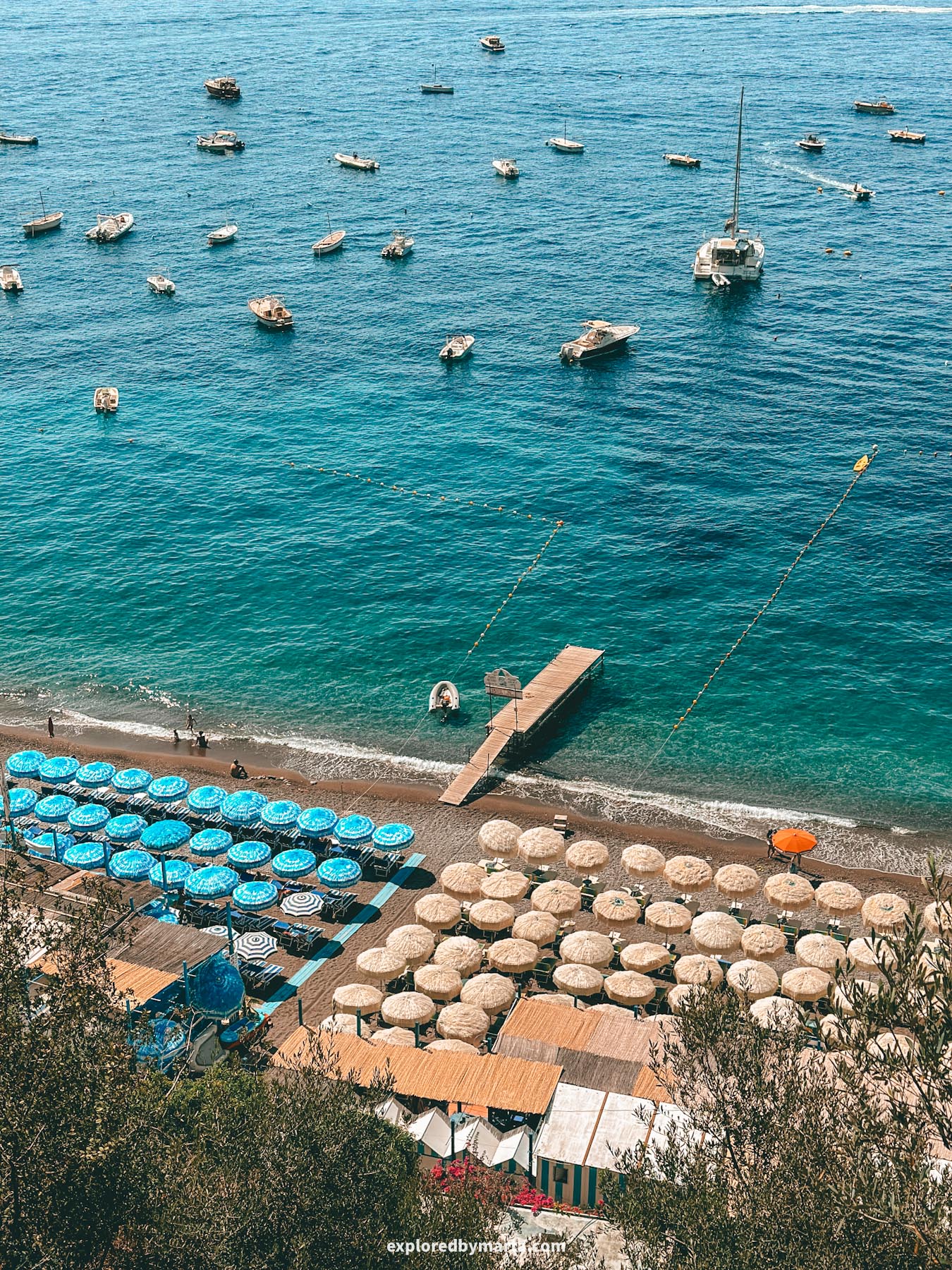
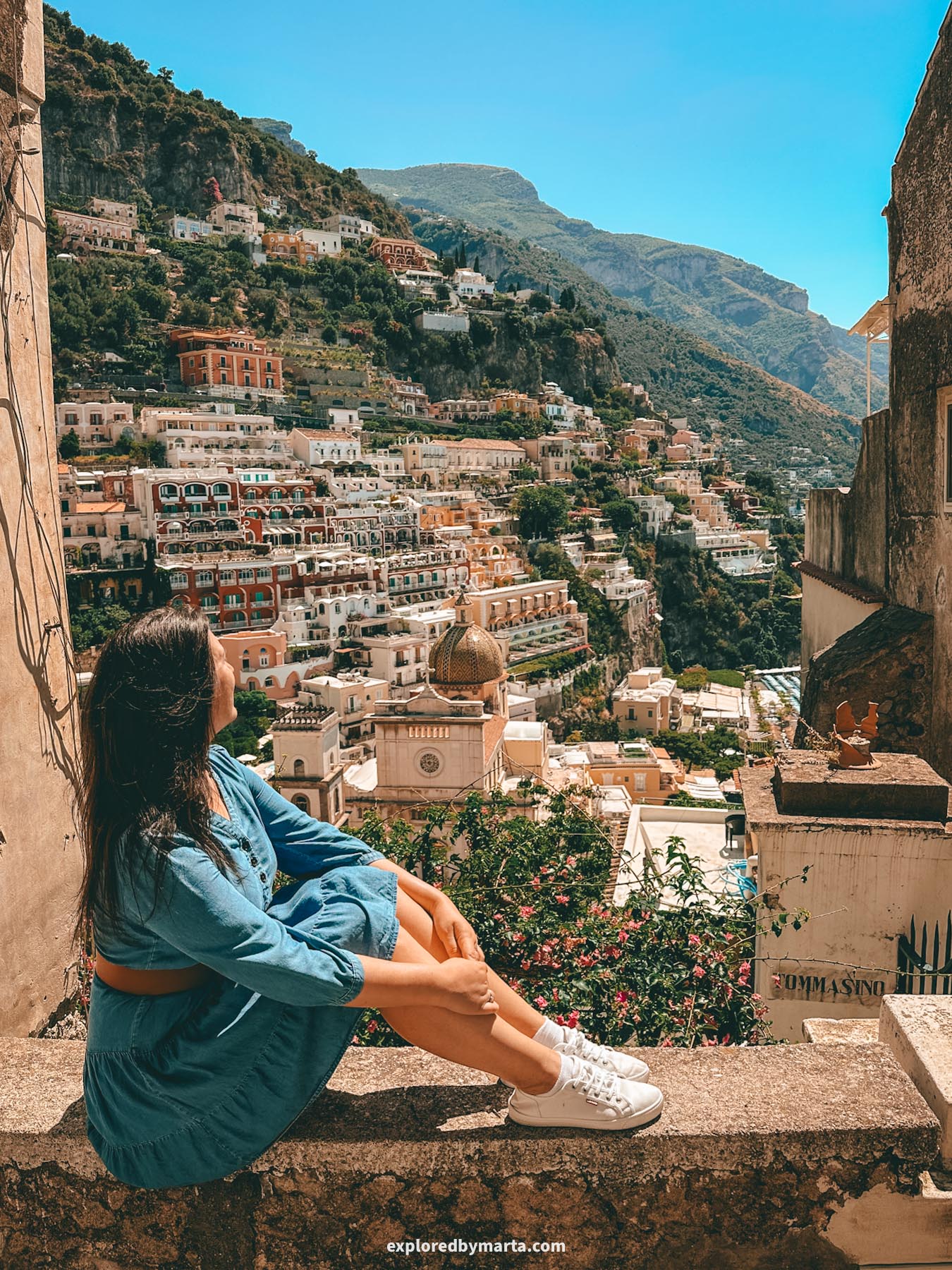
For a quieter beach day, walk over to Fornillo Beach, which is a more peaceful alternative just a short stroll away. We walked over there by Via Positanesi d’America, the most scenic seaside walkway in Positano.
Generally, if you’re tired of the beachfront crowds (the most crowded places in Positano are the beach and Via dei Mulini, the main shopping street in Positano), then just stroll up to some of the higher streets, and you’ll get fewer crowds and better views!
One of the most iconic landmarks in Positano is the iconic dome of Chiesa di Santa Maria Assunta. It stands out with the majolica-tile-covered dome, a typical feature you’ll see on many churches along the Amalfi Coast.
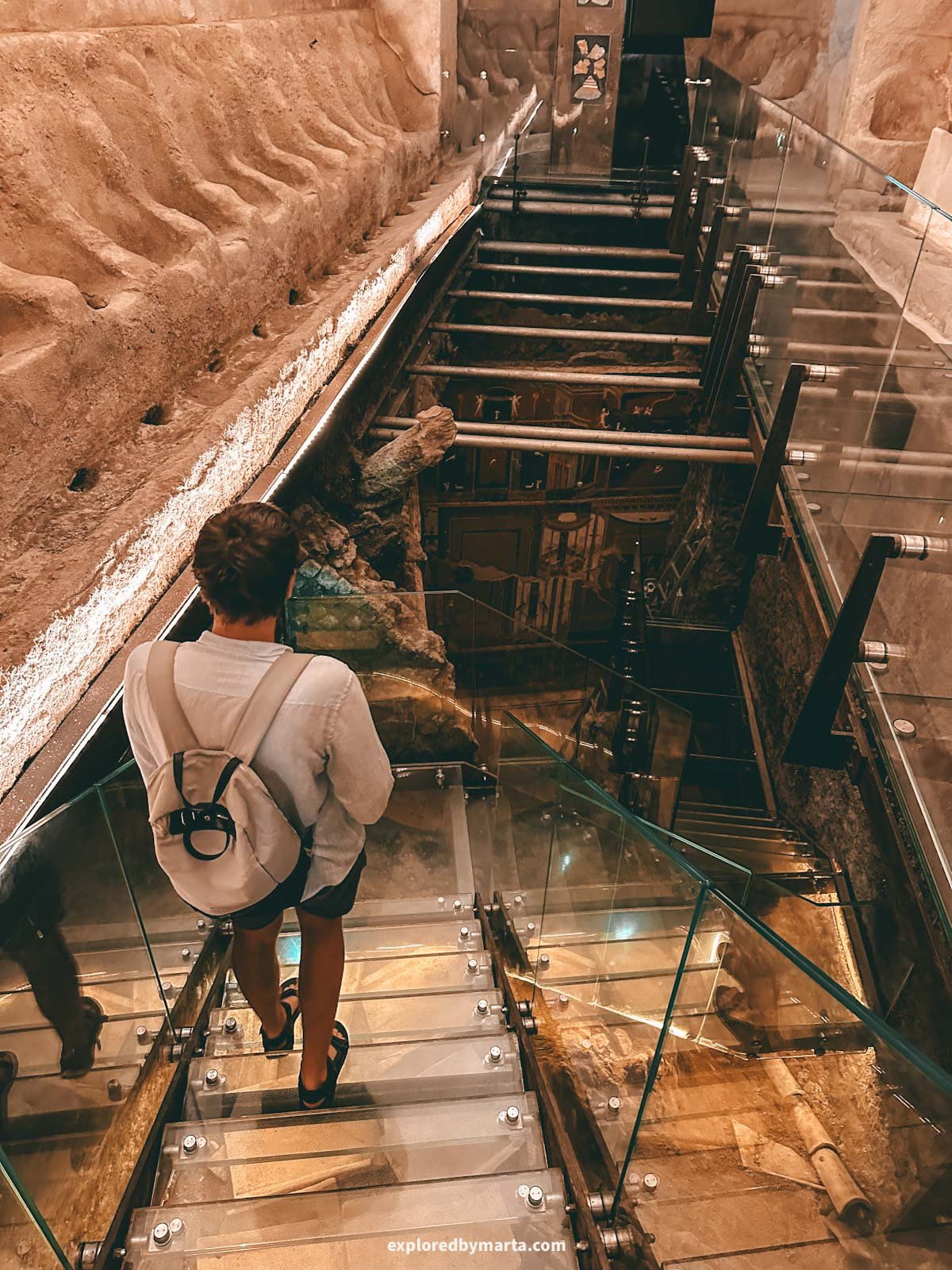
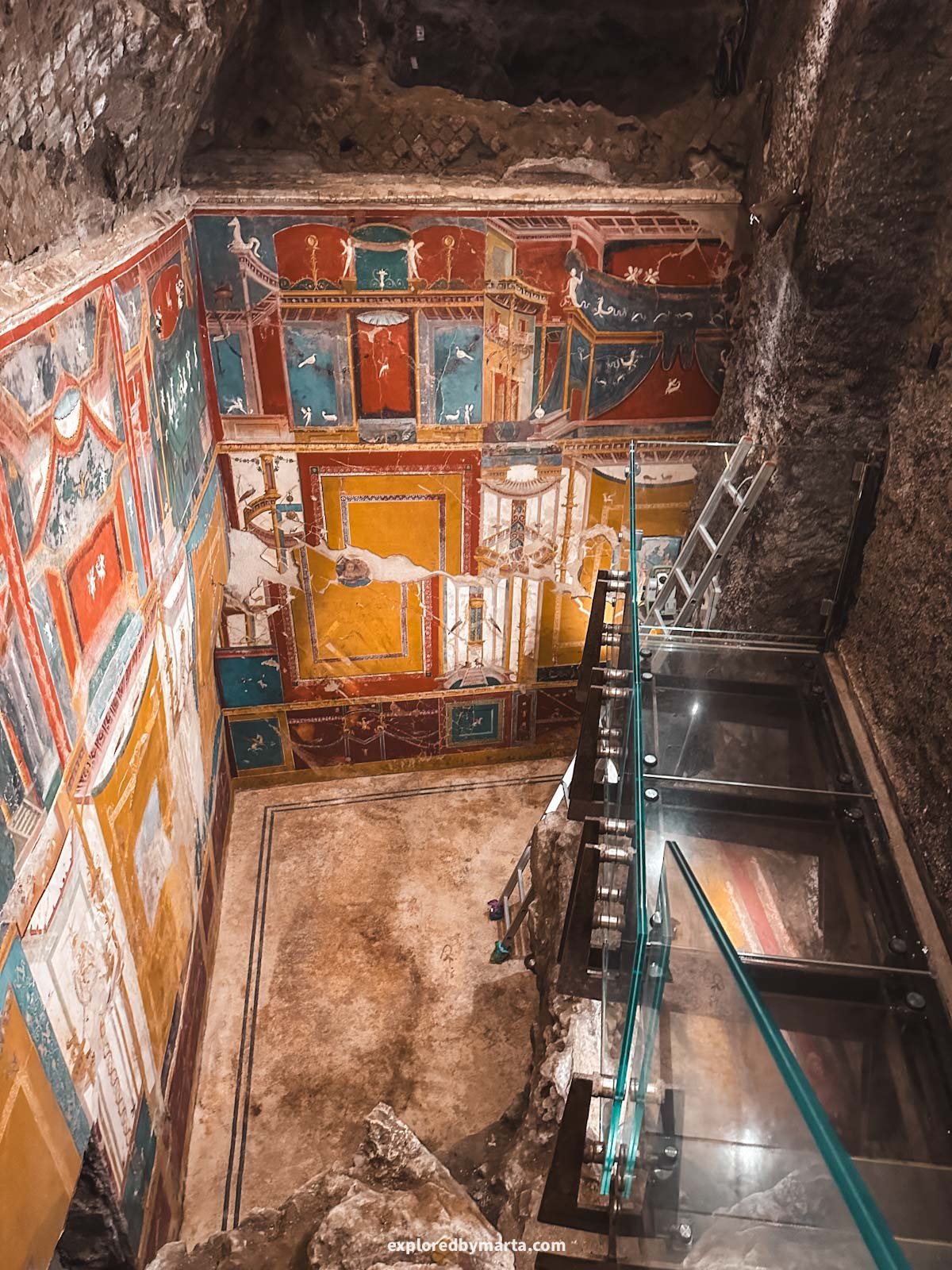
But here’s a hidden gem in Positano – you can actually tour the underground under the church! There is a secret Roman villa dating back 2,000 years, when the eruption of Mount Vesuvius sent floods of mud from the mountain and covering it under a thick layer of soil and ash.
People forgot about the villa and built the town you see today above the ancient villa. If you are a history geek, you’ll love this tour (we absolutely did!).
Positano is also an excellent stop for hikers and nature lovers. The famous Path of the Gods hike starts just above town in Nocelle and offers jaw-dropping views over the Amalfi Coast all the way to Capri. The most scenic hike on the Amalfi Coast!
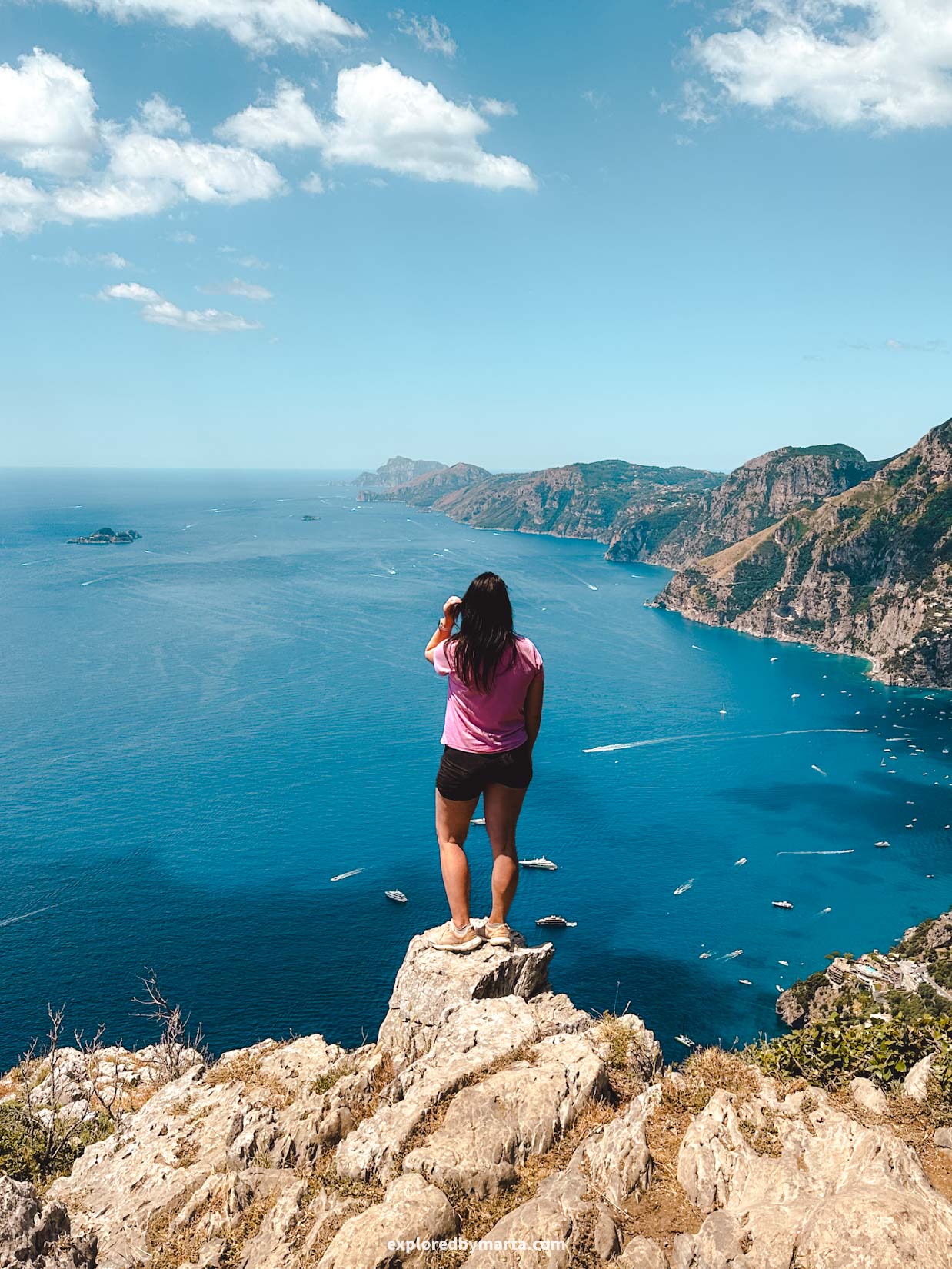
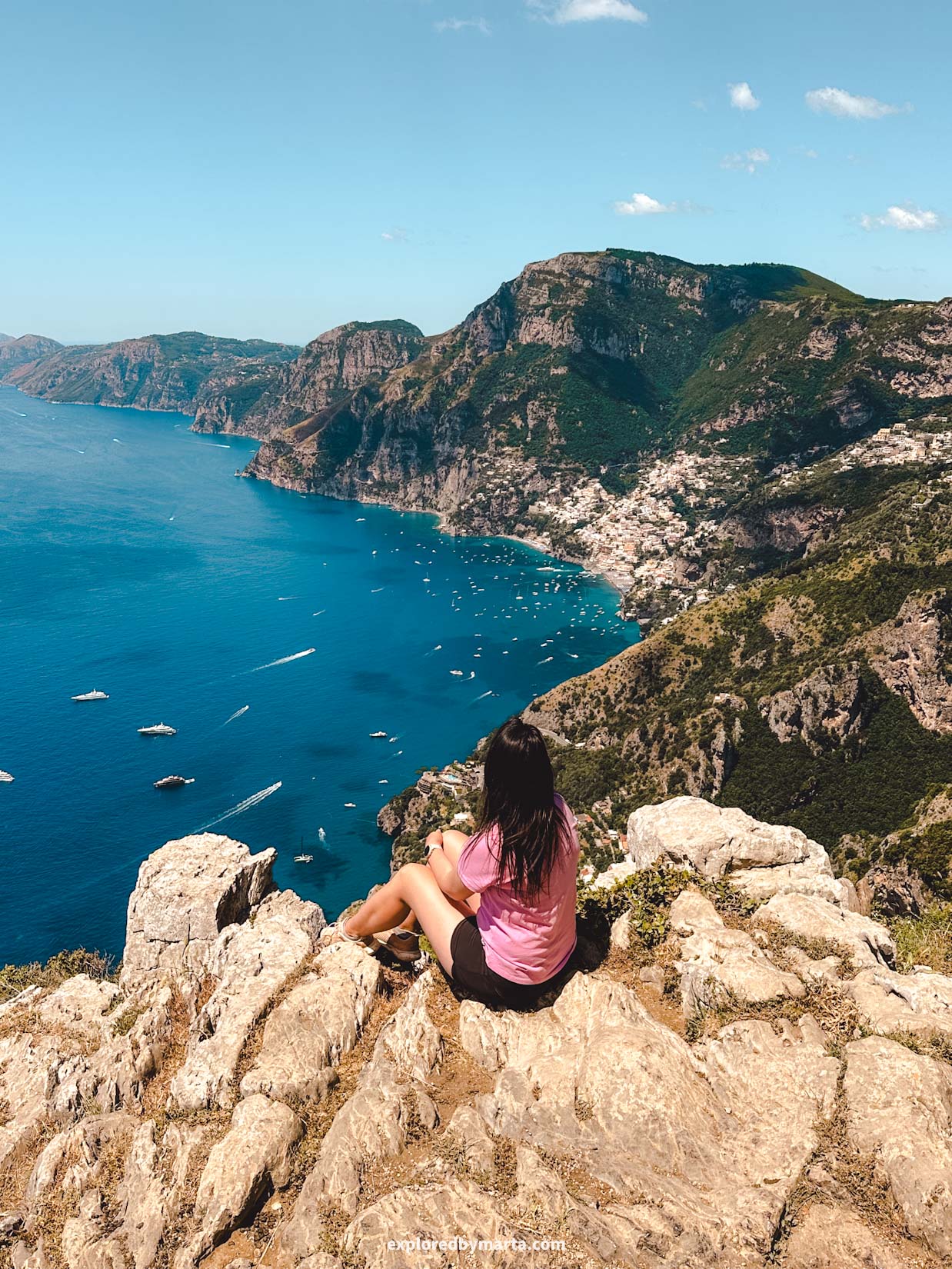
However, I don’t blame you if you only come here for the views of the town. In that case, head to Via Cristoforo Colombo, where you can see that iconic postcard view of Positano. Just stroll along the street and stop by one of the restaurants or bars with a view!
But what about staying in Positano? Well, you definitely can, but it has some of the most expensive hotels on the Amalfi Coast. I also don’t recommend driving here by car, as parking is very limited and very expensive (like 10 EUR per hour).
Most visitors arrive here by ferry, but some also use the SITA SUD bus, which is a cheaper alternative. We used both. The bus is much cheaper, but the ferry will give you those iconic sea views of the town.
Location: Positano
5. Praiano, the peaceful neighbor of Positano
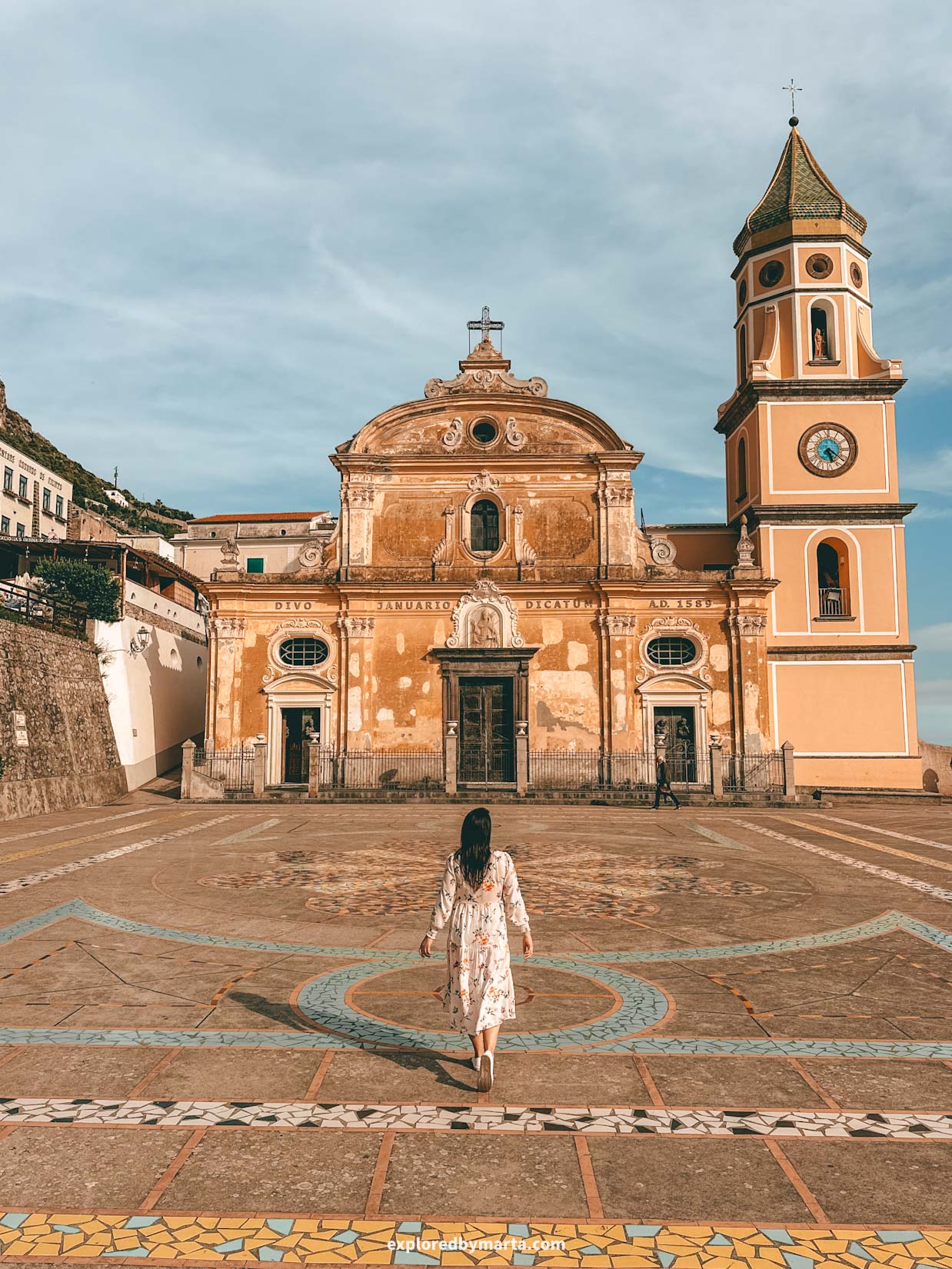
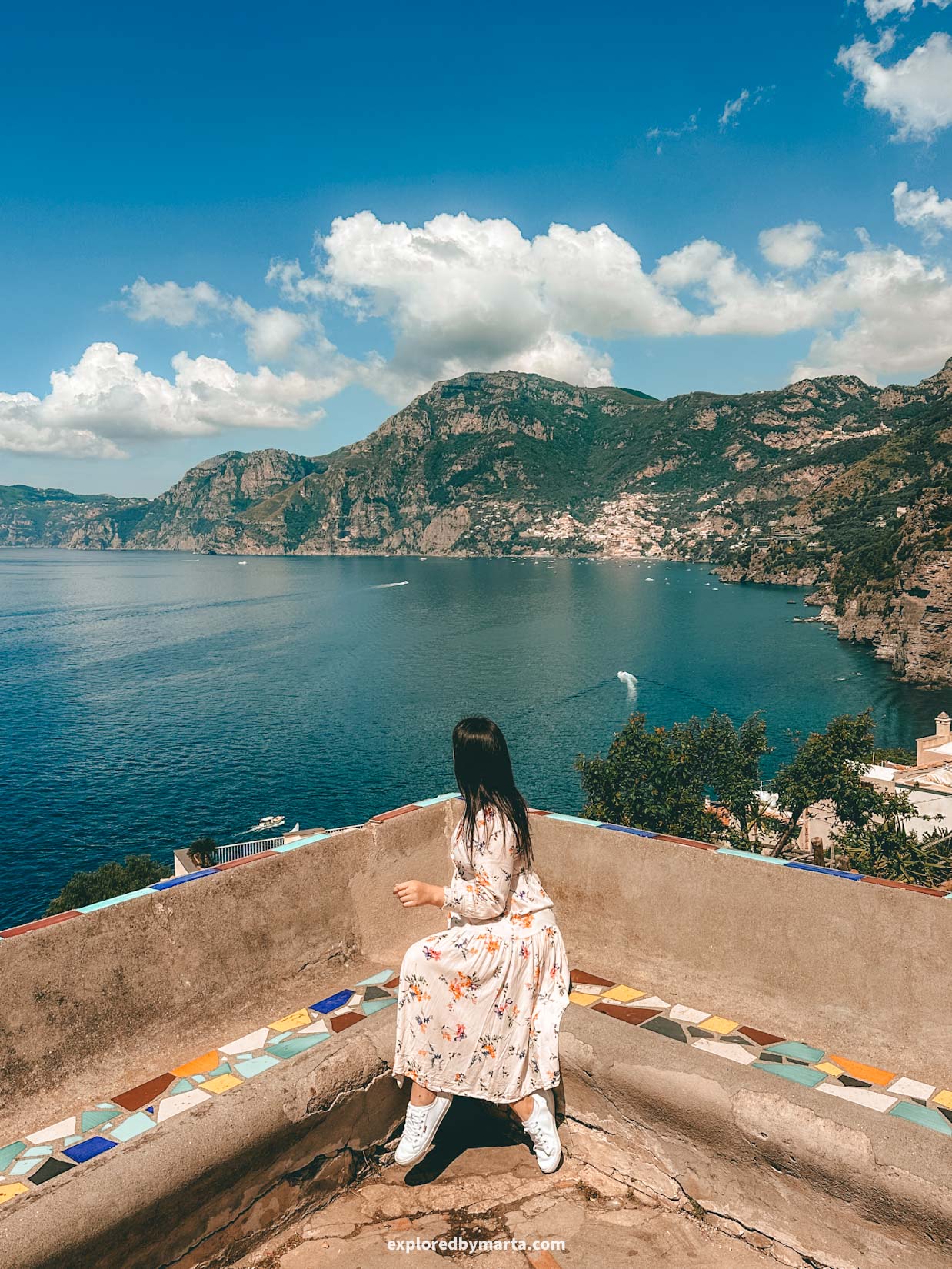
If you’re looking for the same stunning views as Positano but without the crowds (and cheaper hotel prices!), Praiano might just be your dream spot on the Amalfi Coast. This small cliffside village sits right between Positano and Amalfi.
Once a quiet fishing village, Praiano has managed to stay off the radar of most tourists, making it one of the best hidden gems on the coast. I mean, there’s nothing super famous to see, but it does hide some truly beautiful places.
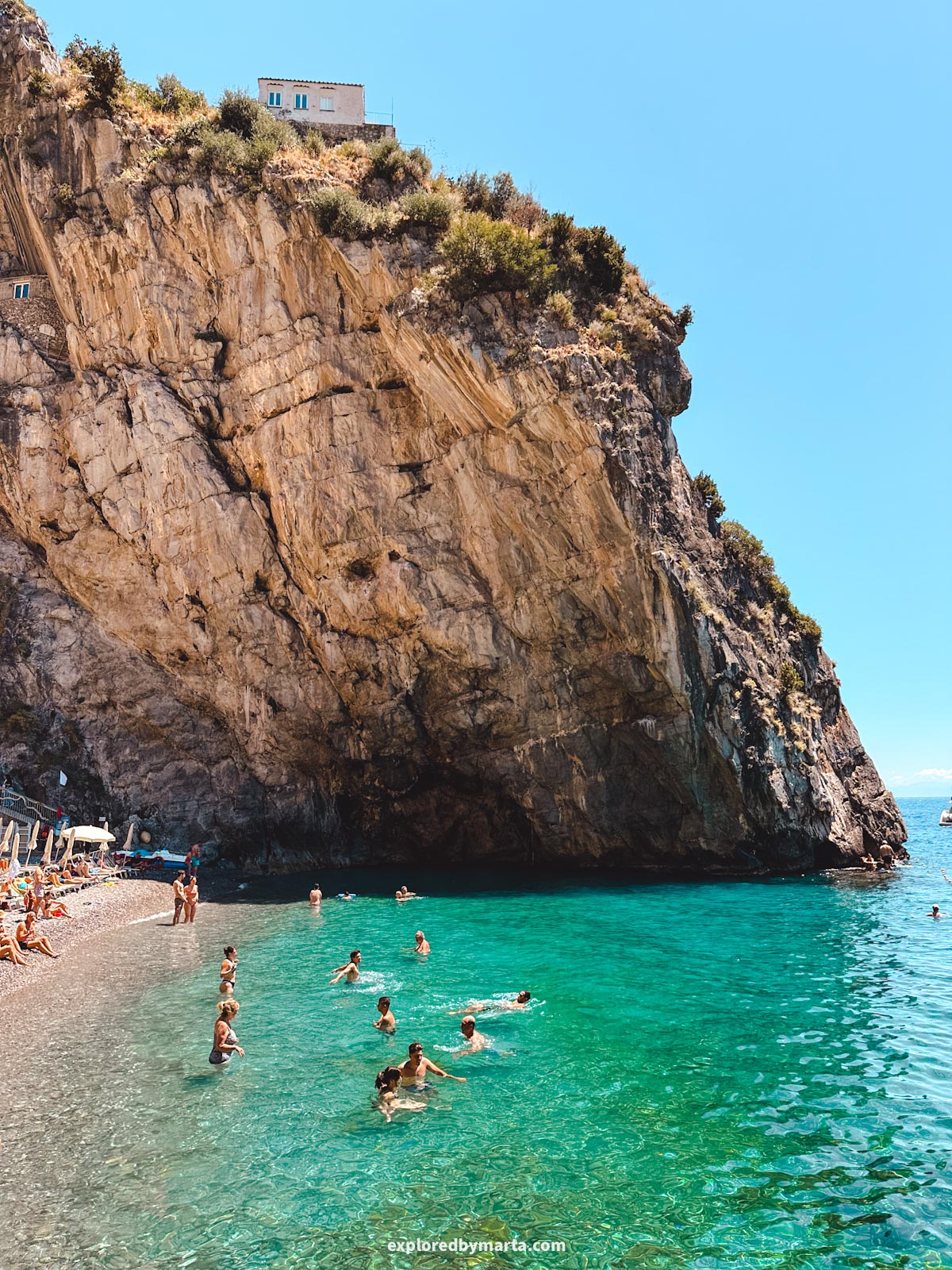
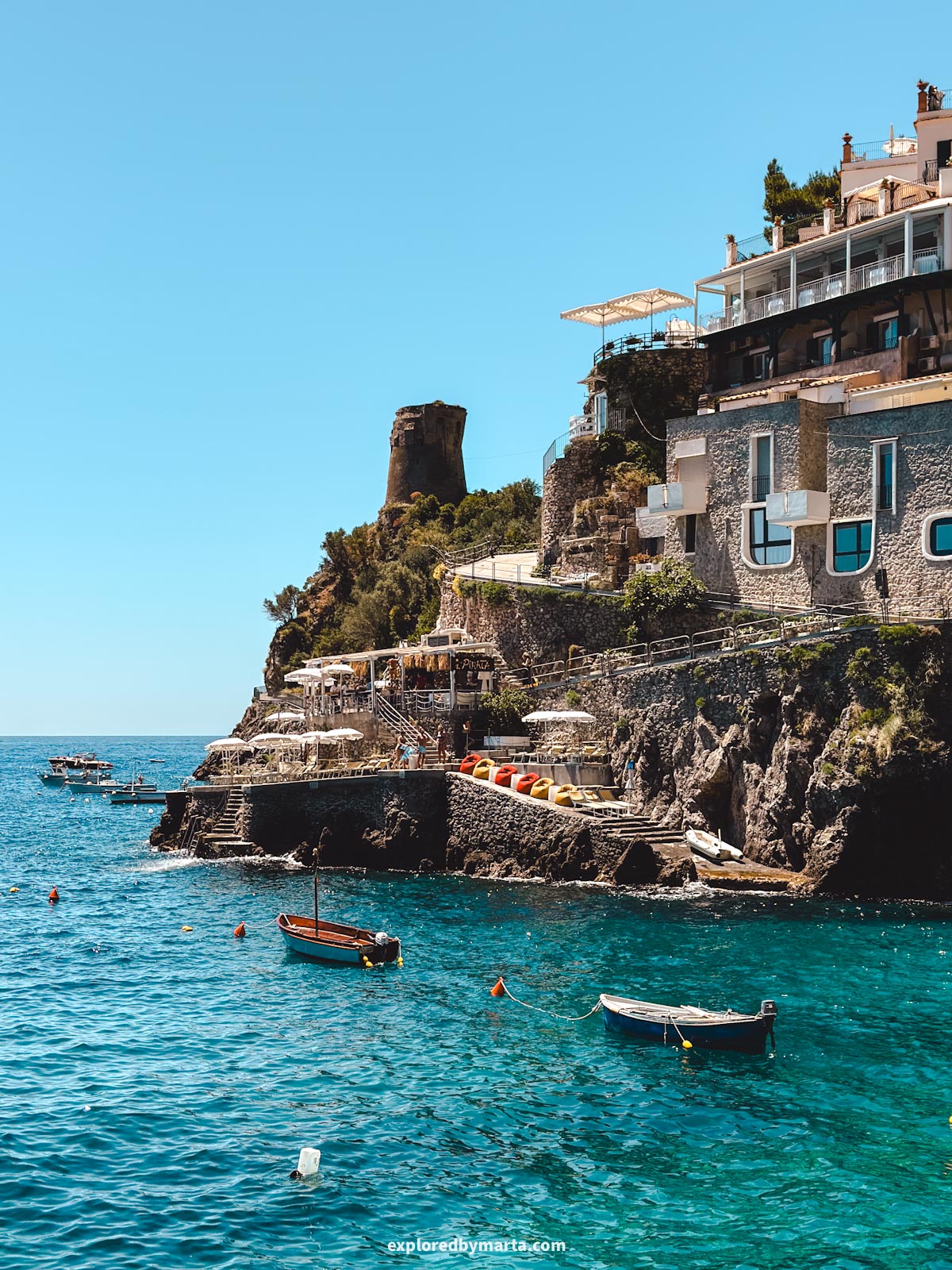
The yellow Church of San Gennaro, with its colorful tiled dome, sits on the cliffside next to the most beautiful and scenic square on the Amalfi Coast. It’s the perfect place to sit and enjoy the sunset, especially when the sky turns orange and the coastline glows.
Praiano is also home to some fantastic spots for swimming, like Marina di Praia, one of the most beautiful beaches on the Amalfi Coast, and the nearby Fiordo di Furore, which is the perfect place for diving into the crystal-clear waters of the Tyrrhenian Sea.
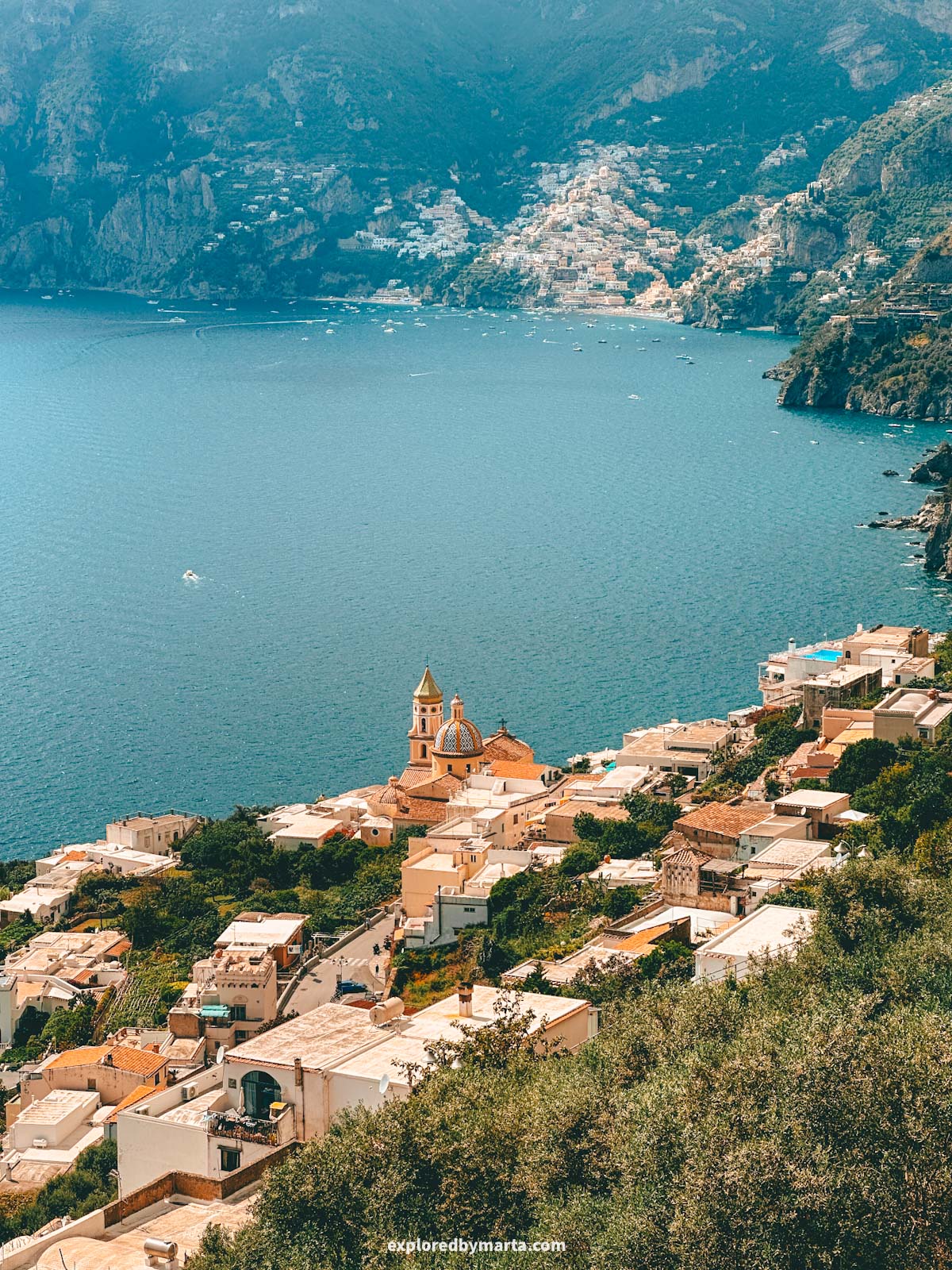
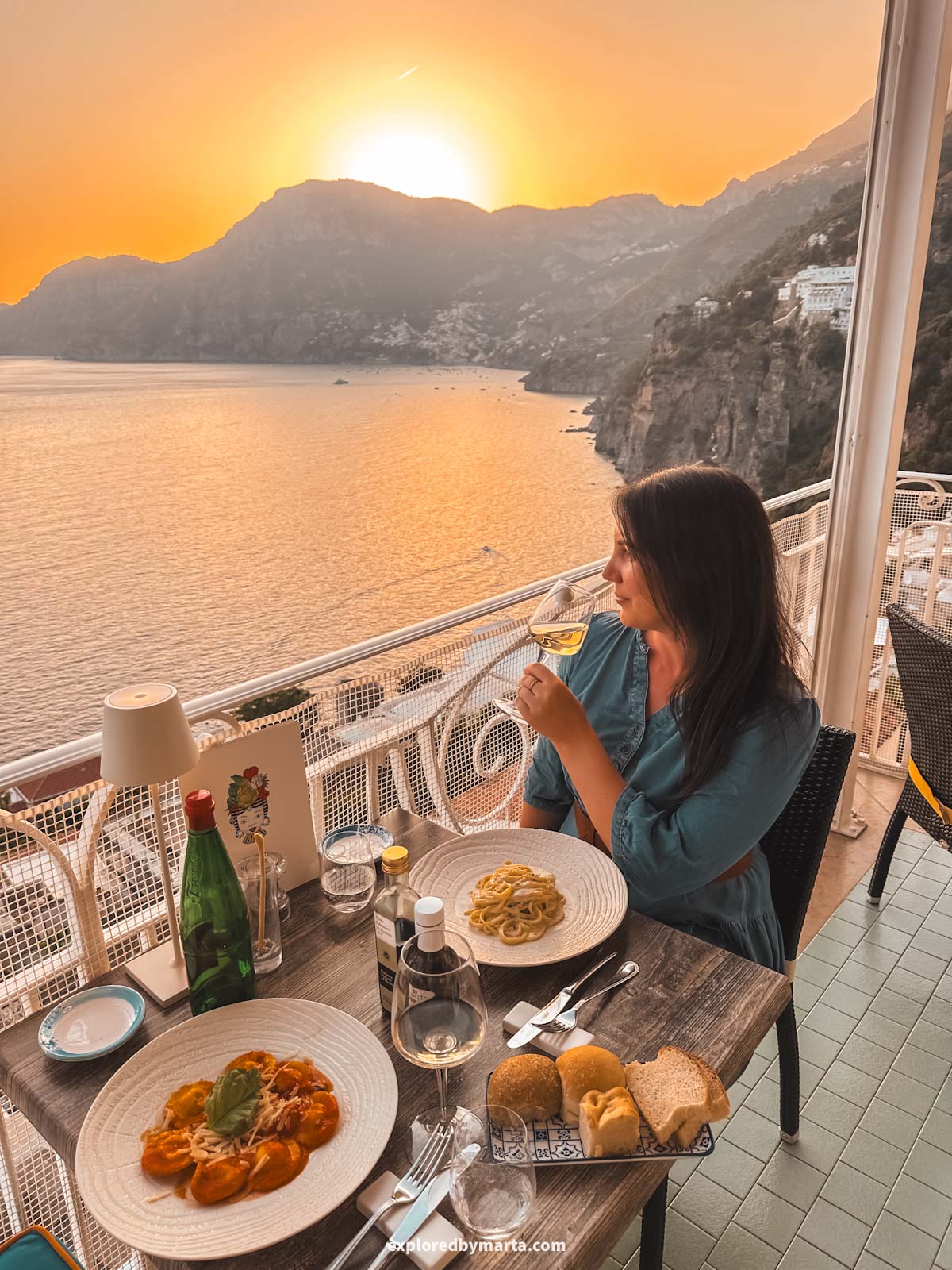
Praiano is paradise for sunset lovers. The village faces west, so finding a restaurant with spectacular views and having dinner at sunset is a must-do thing in Praiano.
And if you’re craving peace and beauty without the chaos, consider staying here instead of its busy neighbours, Positano and Amalfi. It’s an excellent place for exploring the Amalfi Coast – just jump on a bus and go wherever you like.
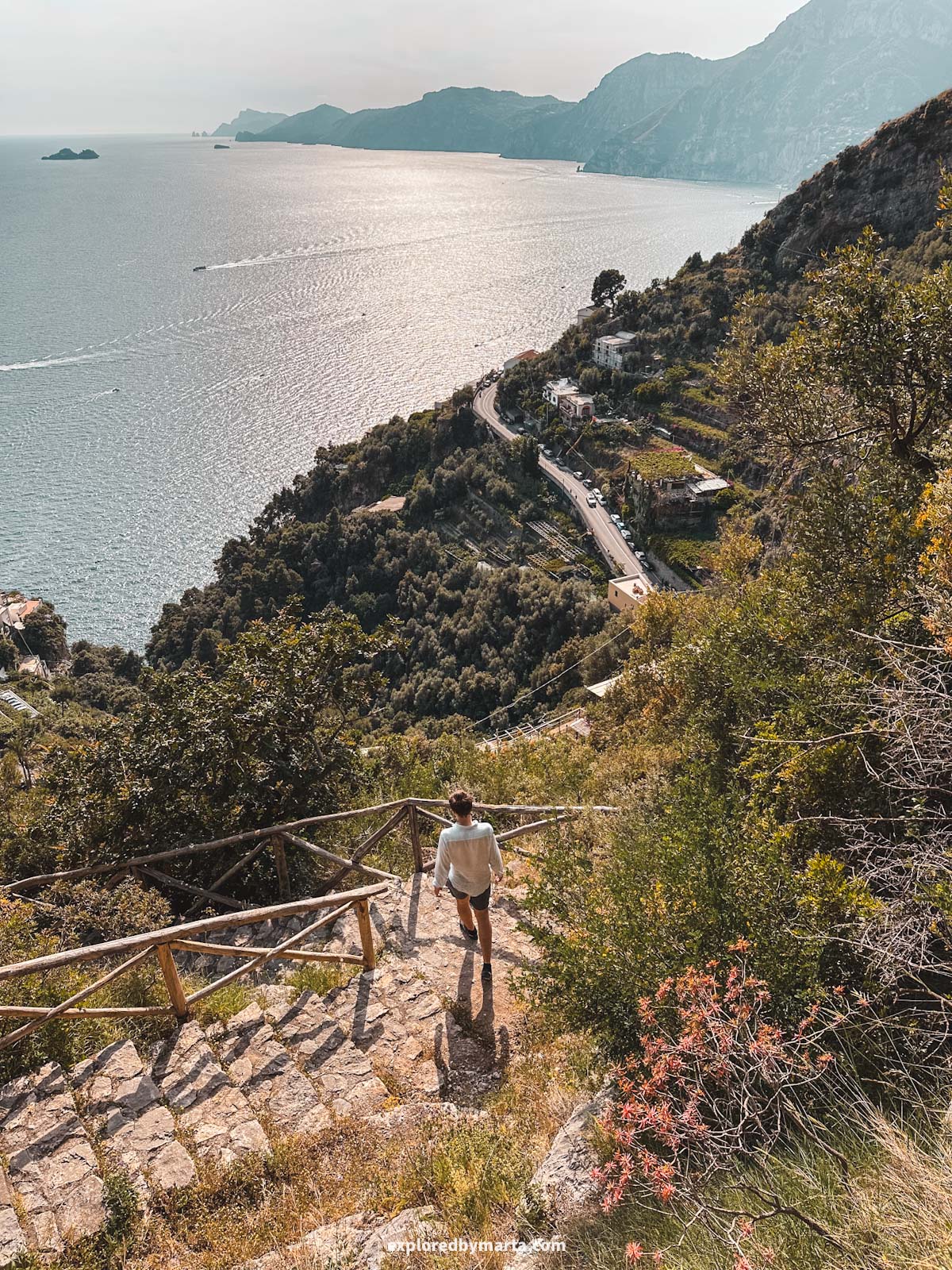
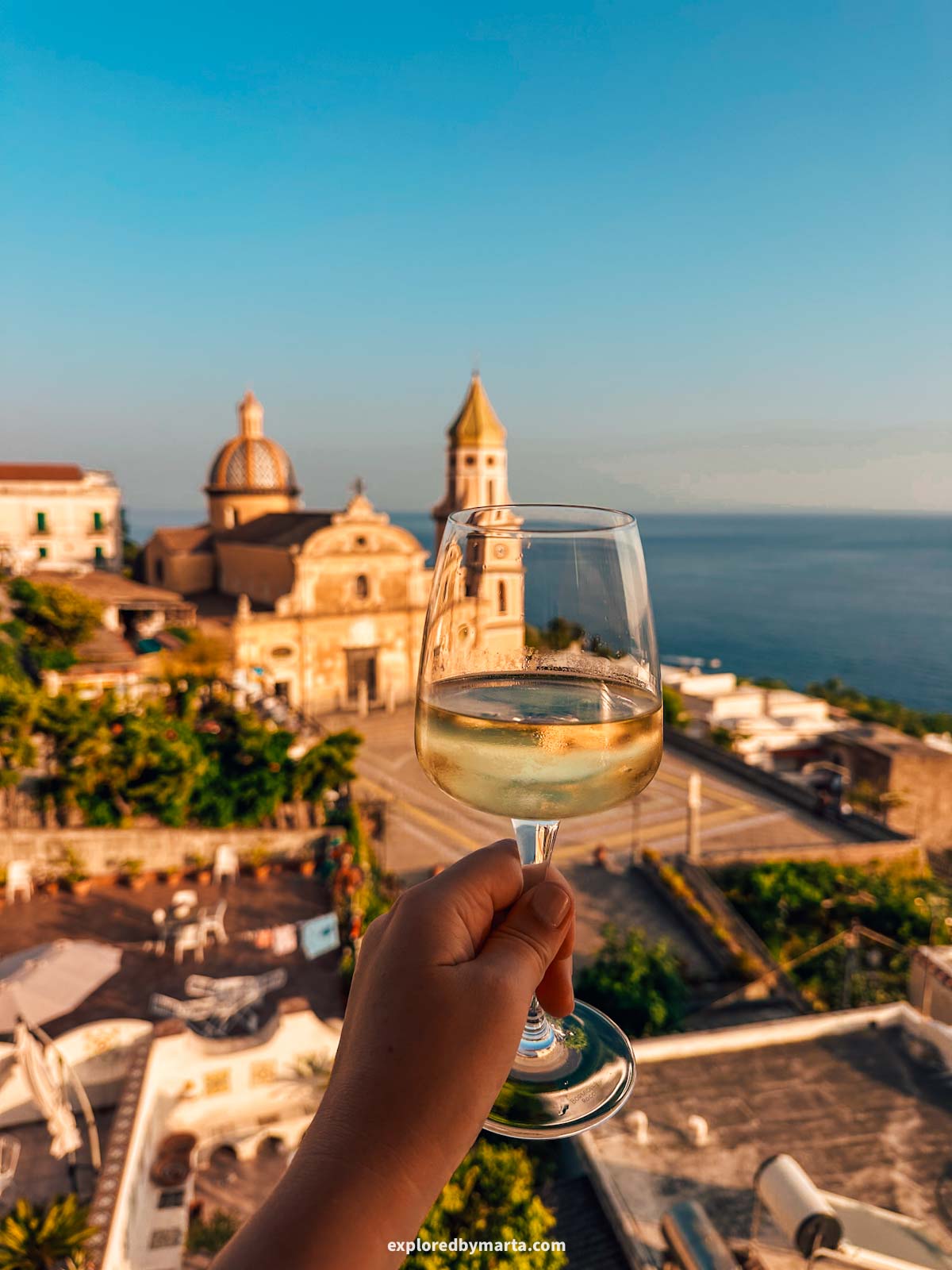
Praiano even offers plenty of opportunities for hikers. We loooved hiking up to the scenic Convento di San Domenico by a beautiful staircase lined with sculptures. It’s a beautiful 16th-century monastery complex with stunning frescoes.
But for a bigger challenge, Praiano is connected to the famous Path of the Gods hike, a must-do adventure when visiting the Amalfi Coast! Just continue along the same path as the route that leads to the convent. But it’s a challenging climb!
Location: Praiano
6. Vietri sul Mare, the gateway of the Amalfi Coast
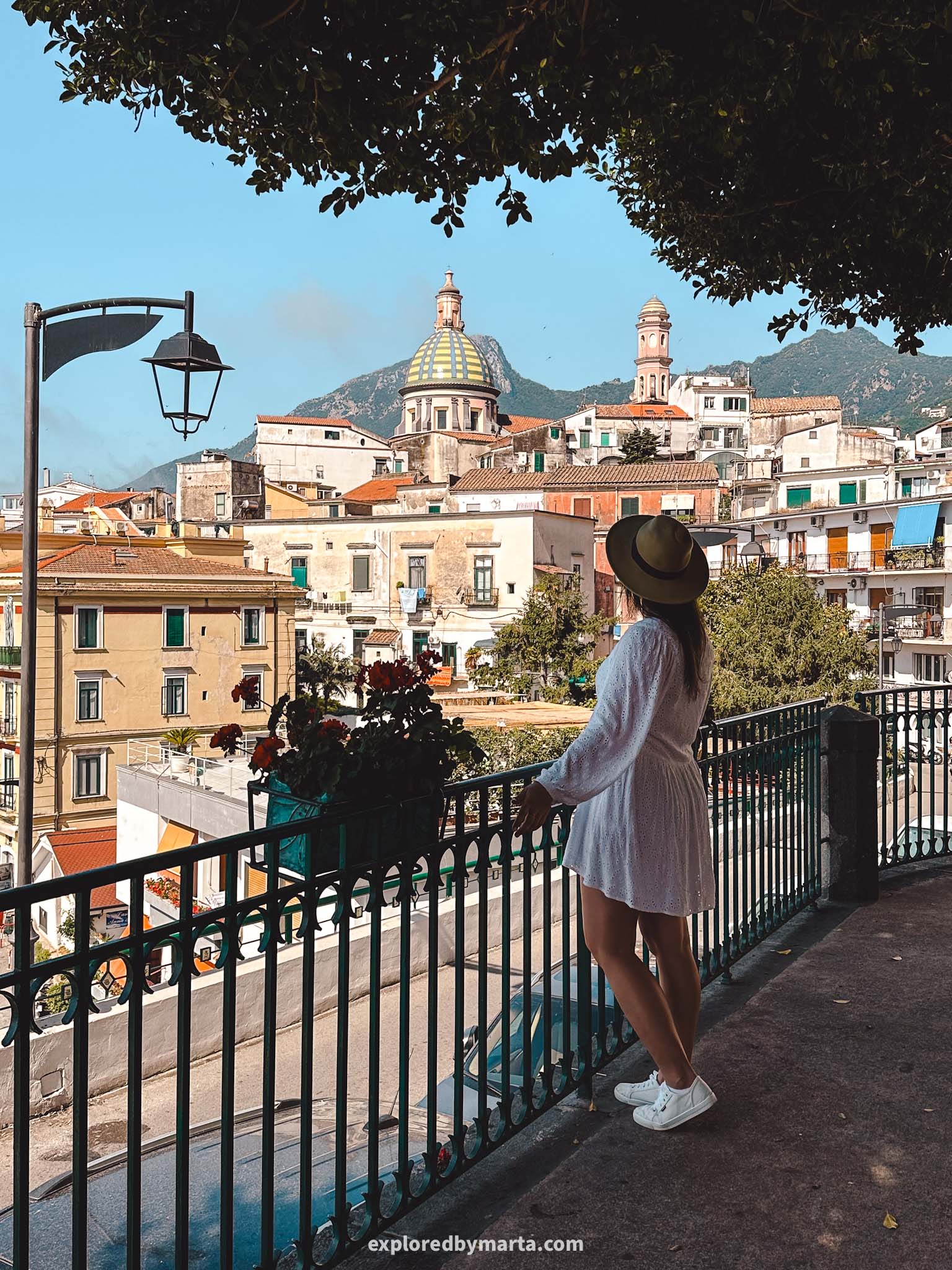
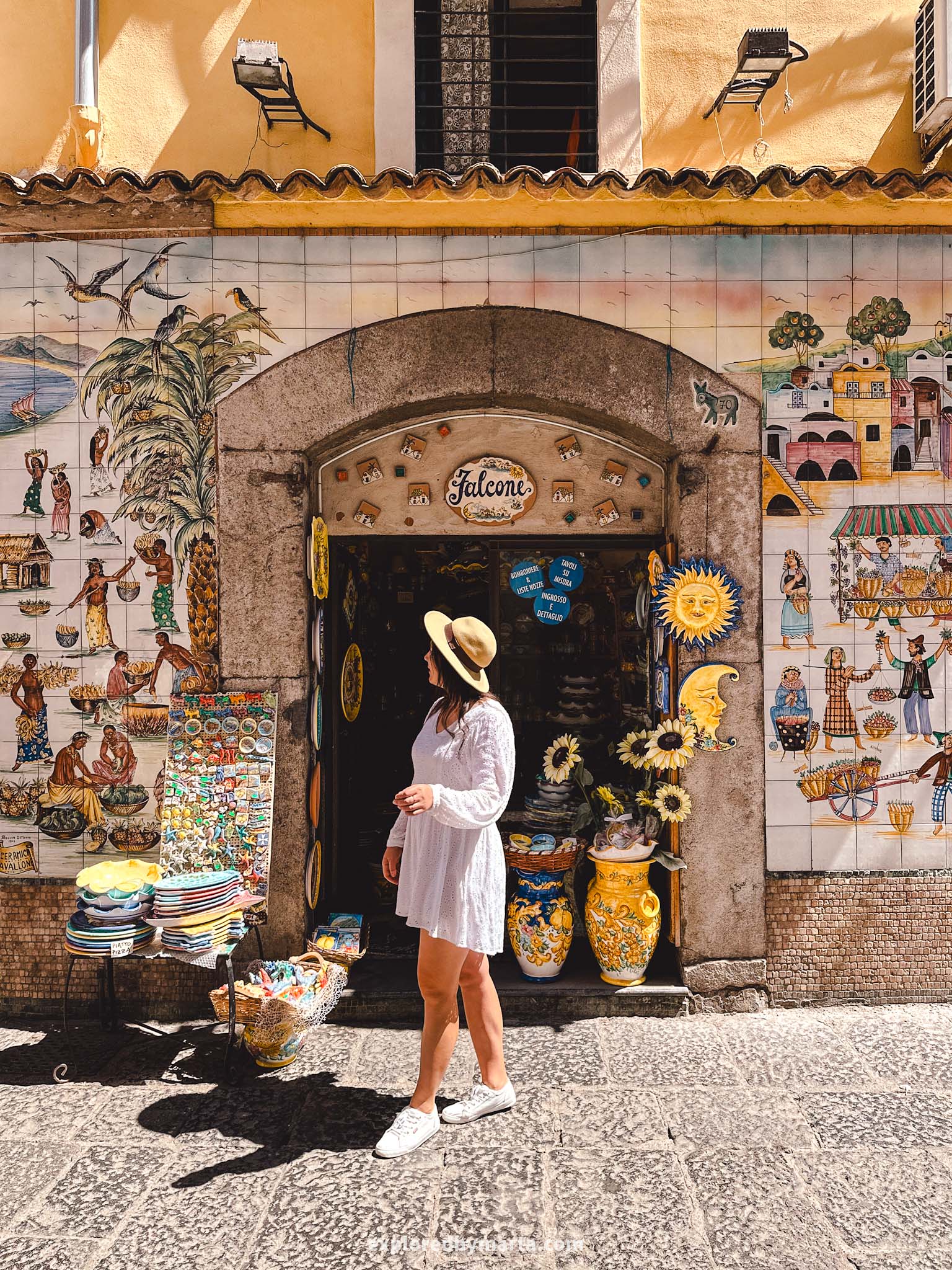
Vietri sul Mare is often called the ‘gateway to the Amalfi Coast’, because it is the first village in line along the Amalfi Coast road.
But it is also known as the ceramic capital of the coast.
Vietri has a long tradition of pottery-making that dates back centuries. Its hand-painted ceramics are famous all over Italy, and you’ll spot them everywhere – on shops, staircases, homes, on church domes, and in hidden alleys.
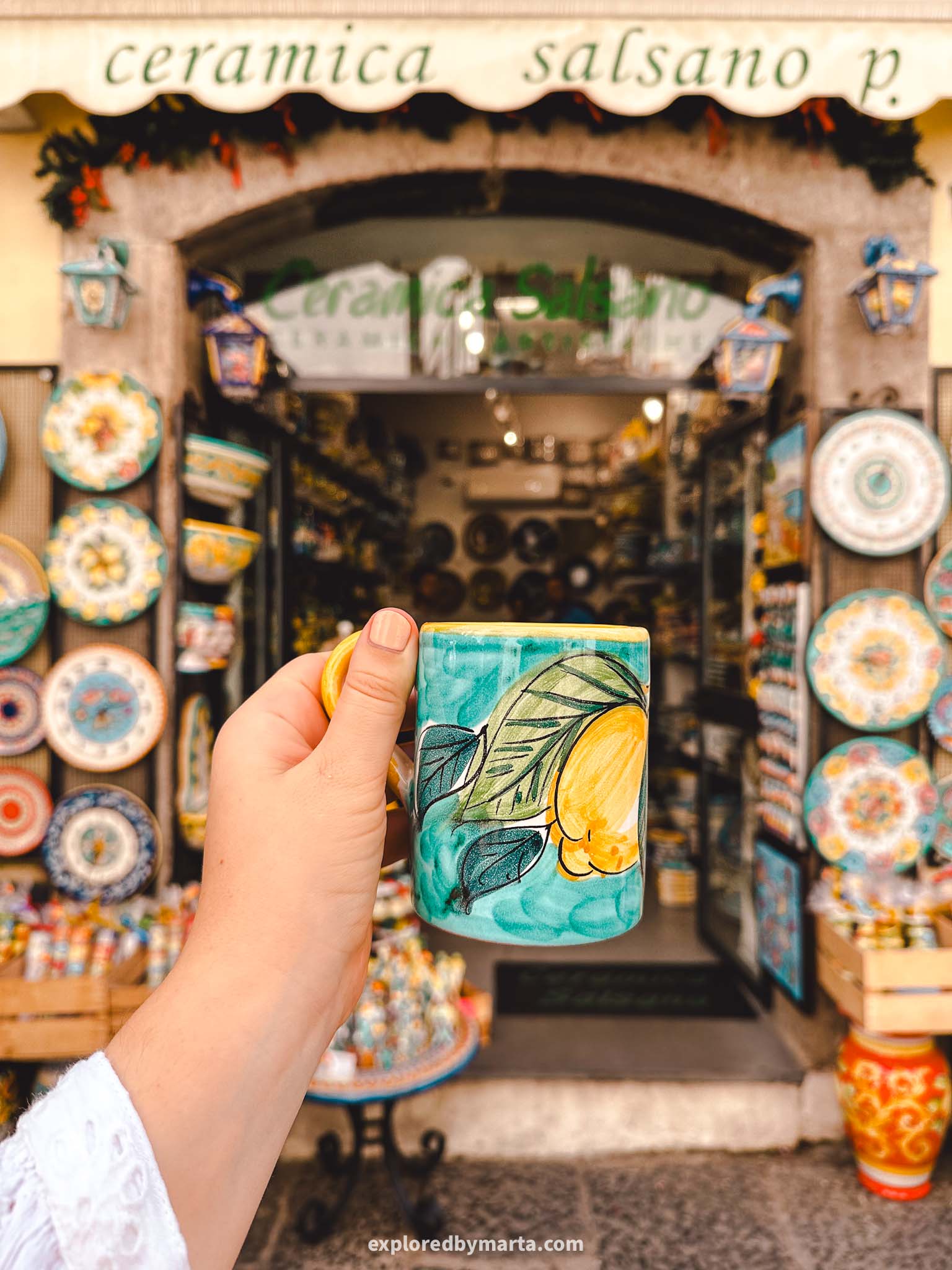
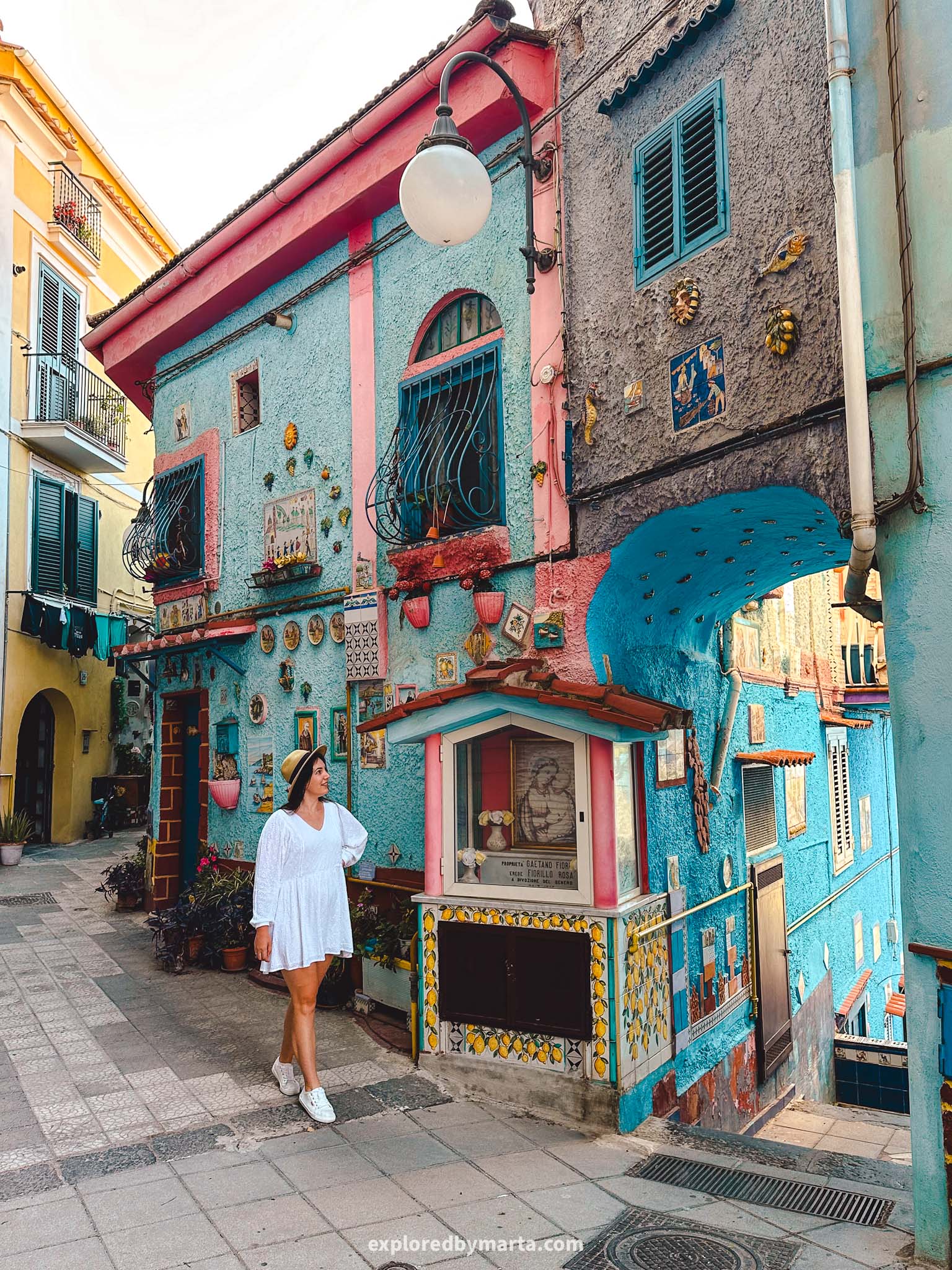
If there is one place you must visit in Vietri sul Mare, it is the main ceramics street – Corso Umberto I. It is filled with countless independent manufacturers’ ceramic shops. I couldn’t even count all of them – there are so many! I bought a coffee mug in one of the stores.
Another place to see is the Church of San Giovanni Battista. With its striking majolica-tiled dome, it is the town’s centerpiece. If you can, definitely take a peek inside to admire its painted ceiling!
Vietri sul Mare also offers something that you don’t see very often on the Amalfi Coast – an accessible, large, grey-sand beach! Plus, the town is well connected to other destinations along the Amalfi Coast, making it one of the top choices to stay.
Location: Vietri sul Mare
7. Maiori, home to the longest beach on the Amalfi Coast
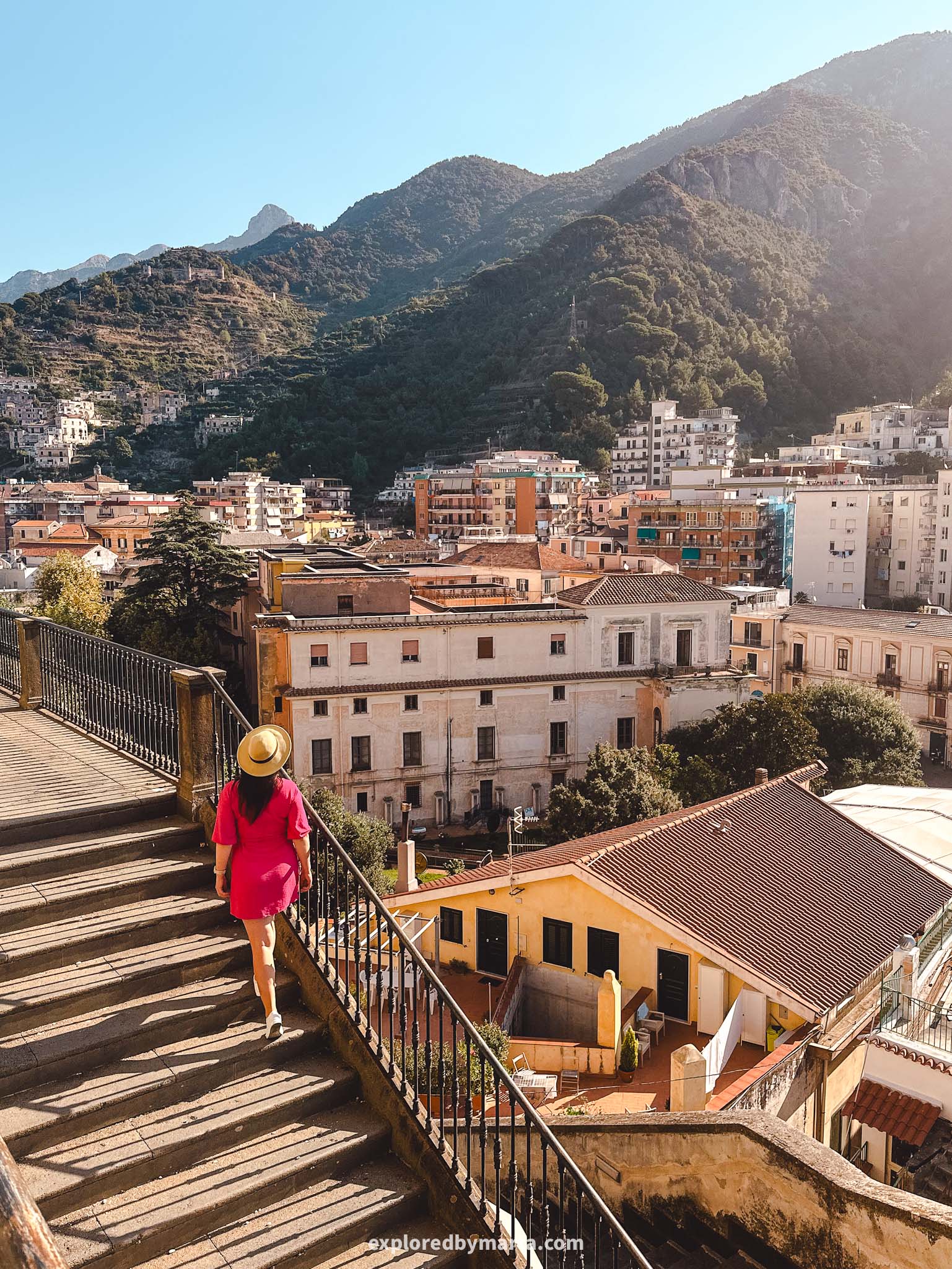
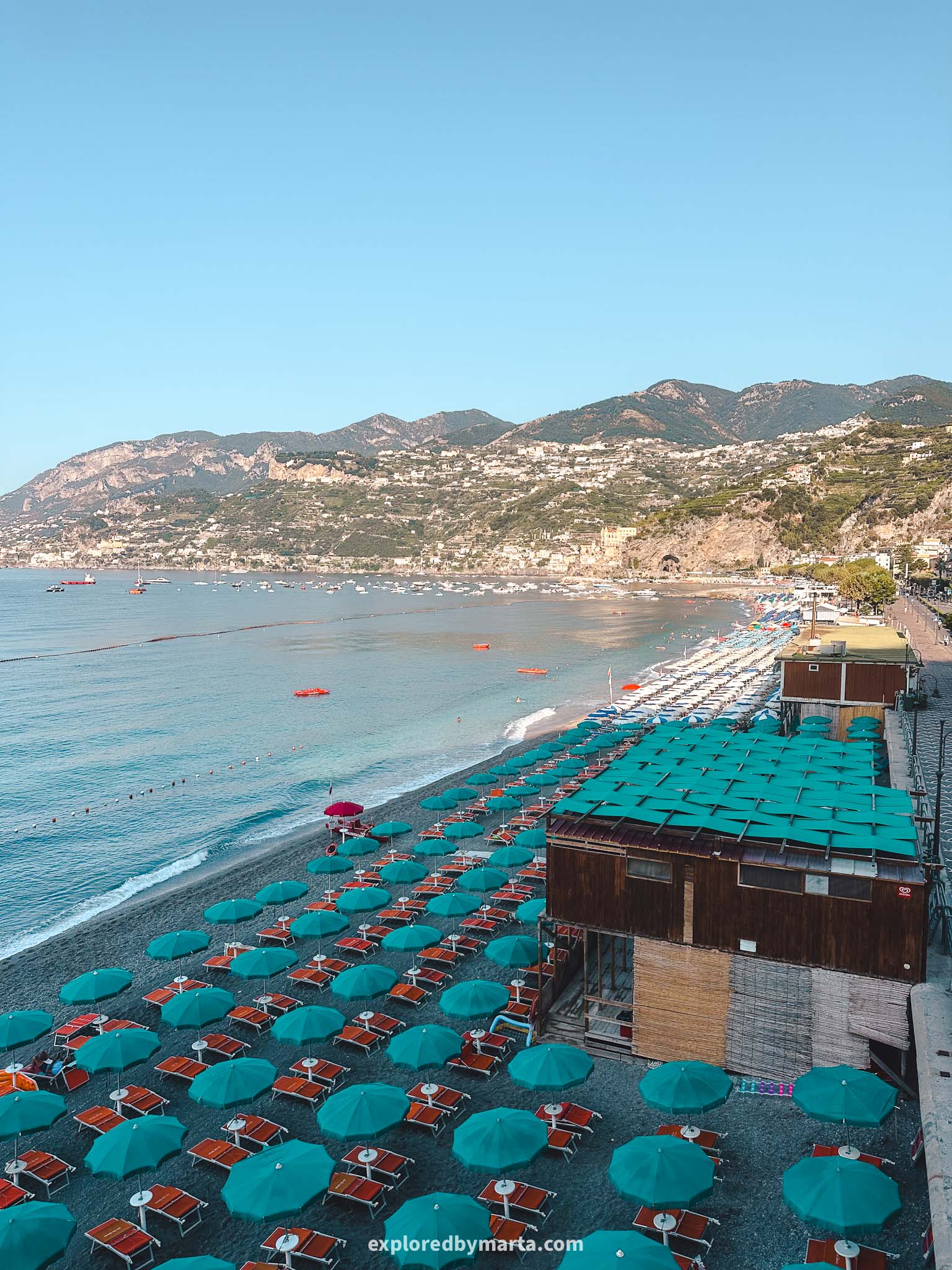
Maiori is one of the bigger villages on the Amalfi Coast, and one of my favorite places we visited along the coastline.
Maiori features the longest stretch of beach along the coastline, a wide seaside promenade, and less crowded streets than in other major villages on the Amalfi Coast, making it the perfect place to stay.
We are runners, and we often drove right here to Maiori for a morning jog along the sea during our travels. But here is also a lot to see and explore in Maiori.
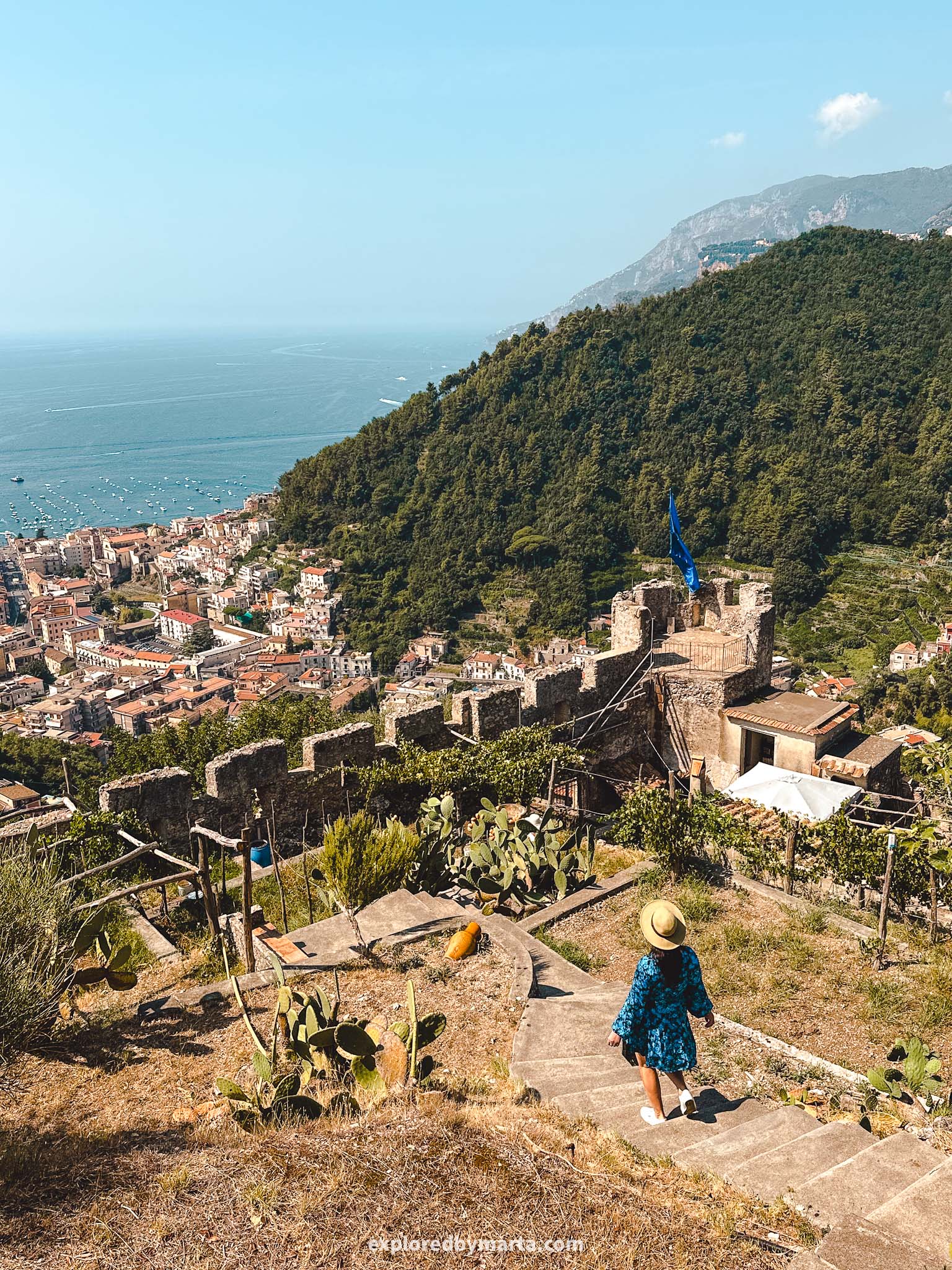
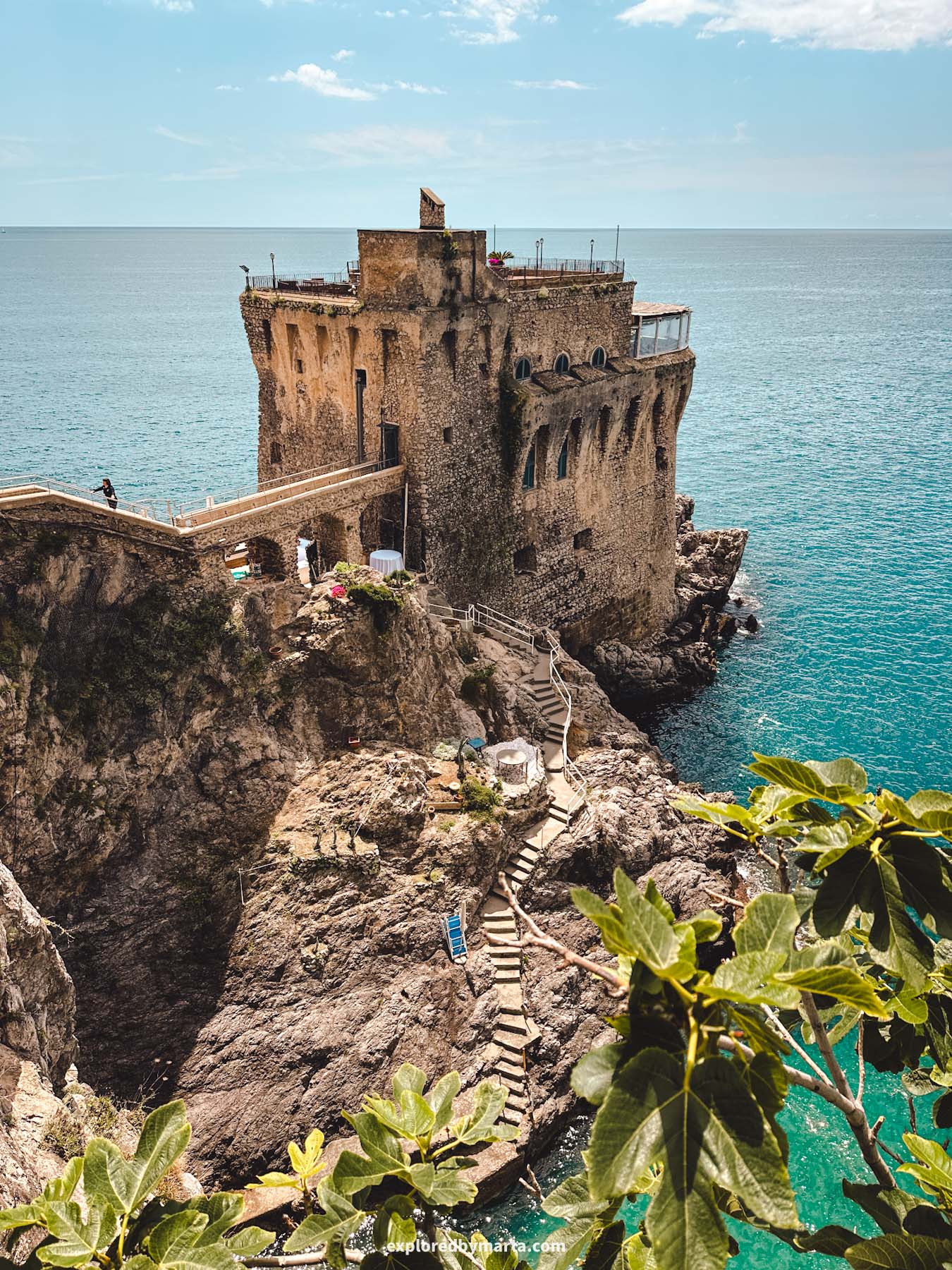
The village was originally founded by the ancient Romans, and Maiori has been rebuilt and reshaped several times over the centuries.
It is home to the beautiful Collegiate Church of Santa Maria a Mare, perched on a hill with views over the sea and the whole town. This is also where the famous Path of the Lemons starts, a popular walk that connects Maiori to its smaller neighbour, Minori.
The historical path goes through lemon groves and under vines, and was used as a transportation route to deliver fruit to markets and ports. Even today, you can see donkeys transporting cargo along the lemon path. No car can drive there.
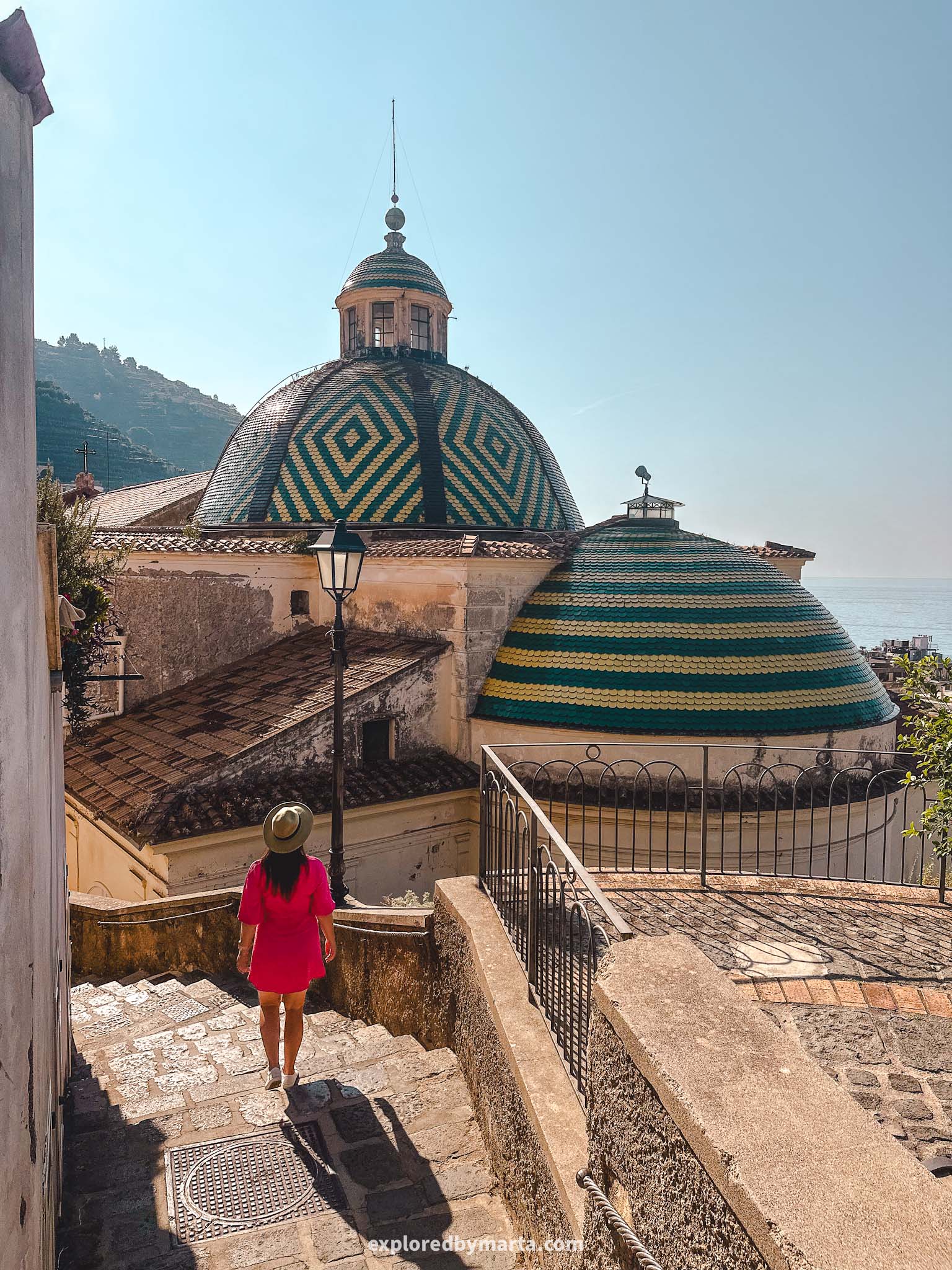
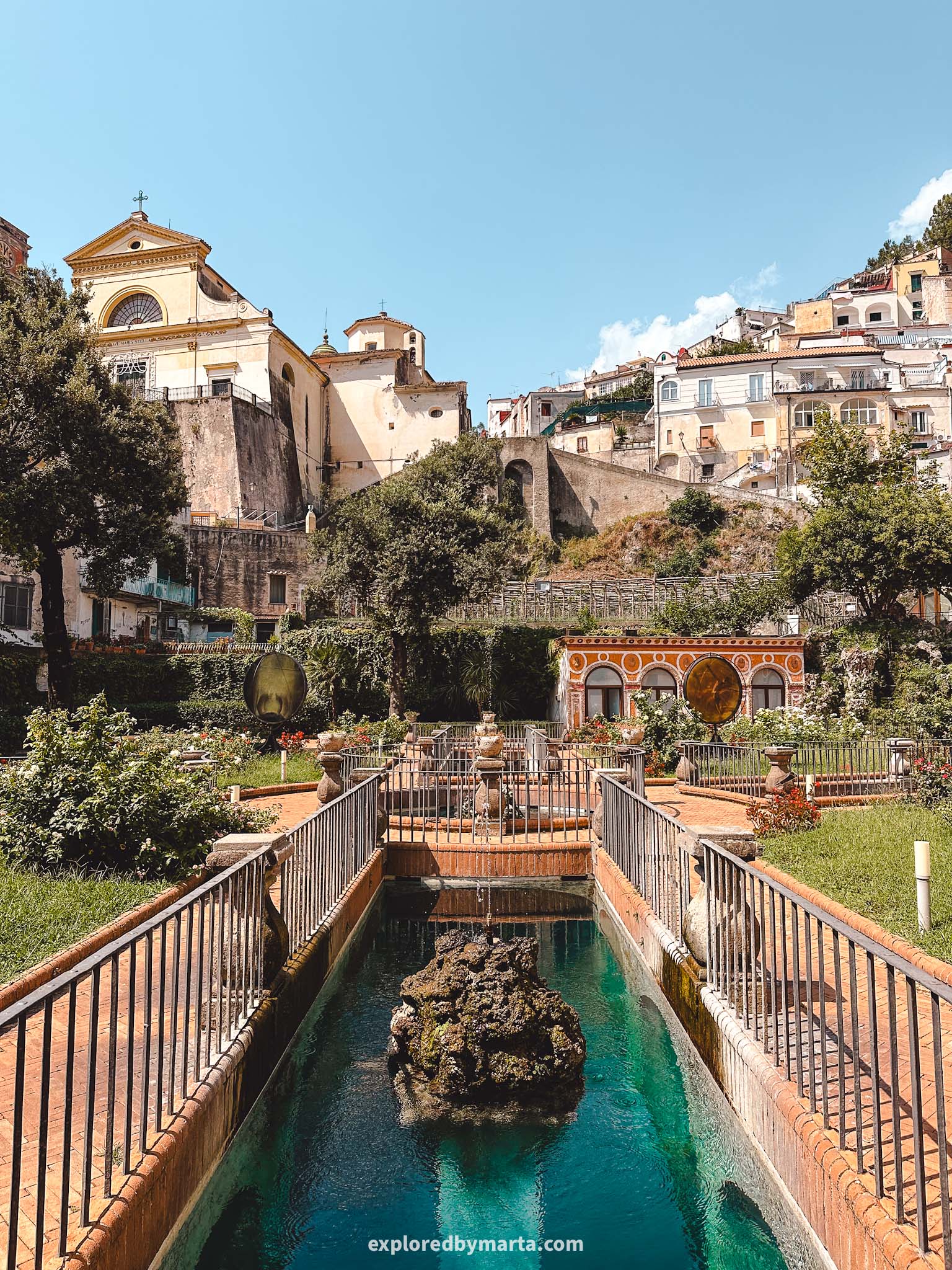
One of my favorite places in Maiori was the Norman Tower, a defensive watchtower that was built to protect the village against pirate attacks. Today, it has been turned into a restaurant where you can have a scenic lunch with breathtaking views of the turquoise waters.
Another one of my favorites is the hilltop castle deeper inland. The 9th-century Castello di San Nicola de Thoro-Plano overlooks the Maiori and offers the most spectacular views of the peninsula. You can access it from the Maiori center by a well-marked stairway.
Maiori might not be the most glamorous place on the Amalfi Coast, but it is an excellent base for exploring the rest of the coast. It’s well connected by public buses and ferries, and its larger size means more hotel options at more affordable prices.
Location: Maiori
8. Minori, the City of Taste

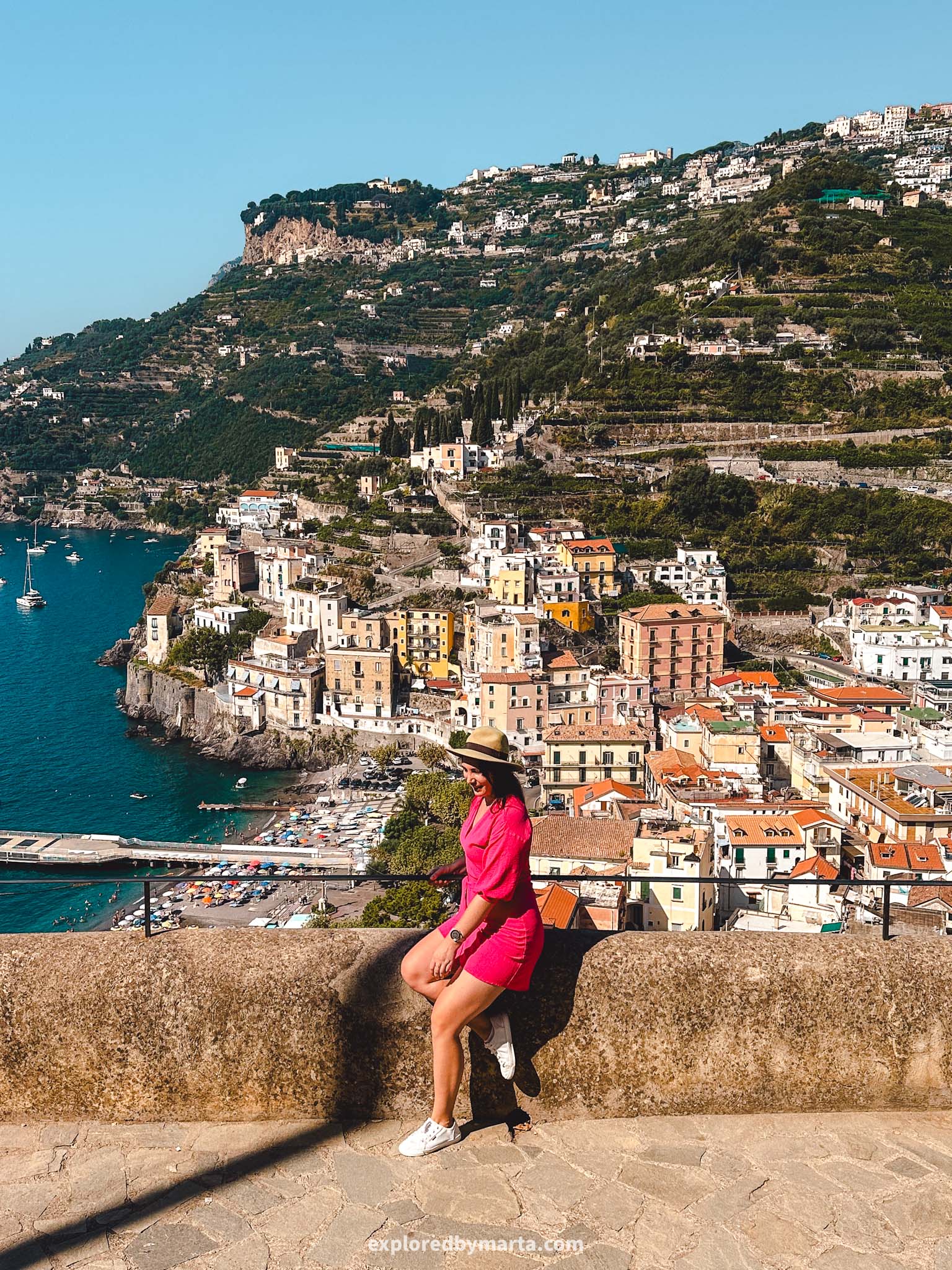
Maiori is one of the smallest villages on the Amalfi Coast, but it is definitely one of the most picturesque villages as well. The charming town is full of history and delicious food.
Minori is known as “the City of Taste,” thanks to its long tradition of pasta-making, lemon cultivation, and pastry mastery. This is where you will find the most famous pastry shop on the Amalfi Coast – Pasticceria Sal De Riso.
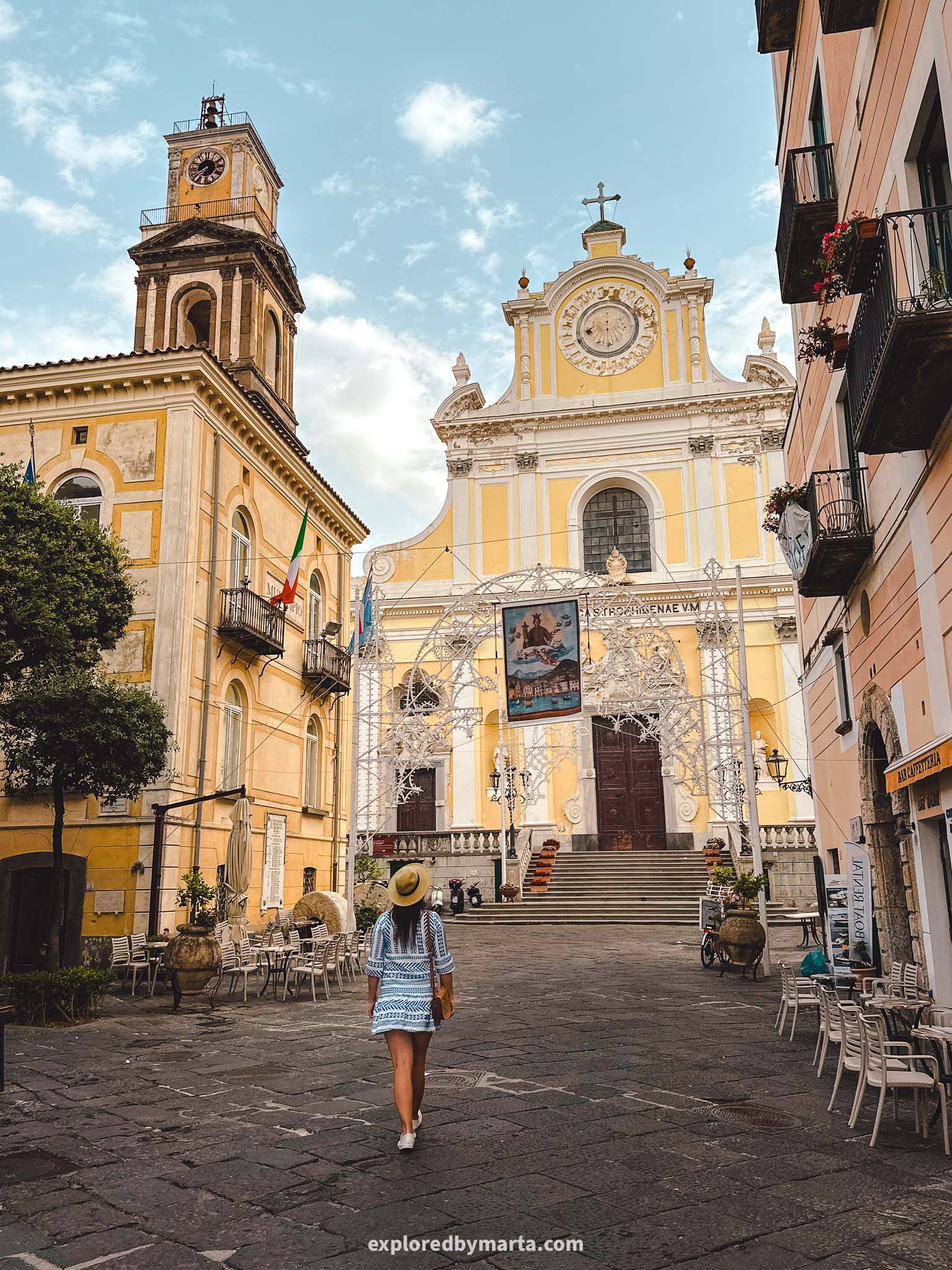
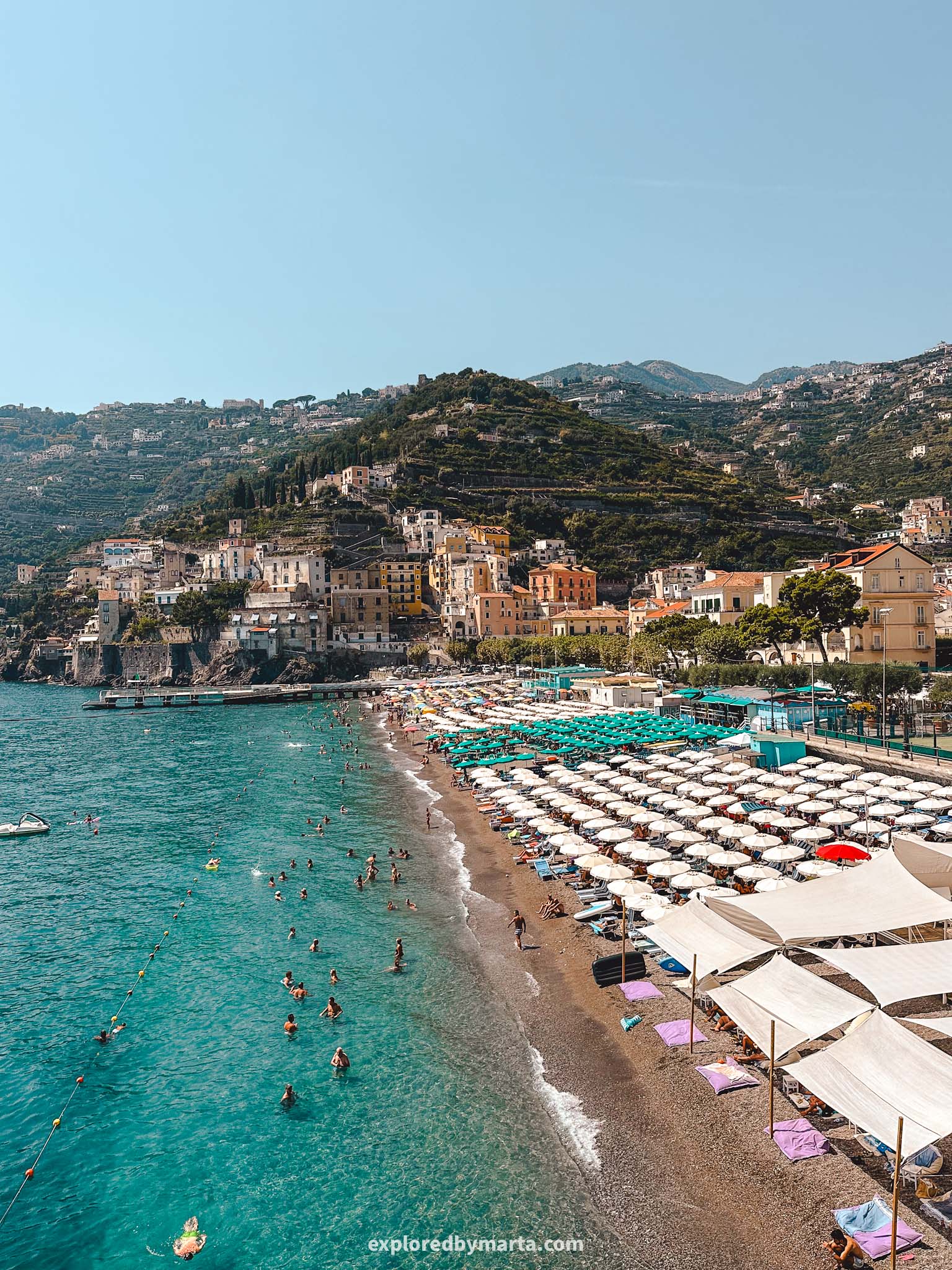
Its award-winning pastry chef invented the must-try Amalfi Coast dessert – Delizia al Limone, and I recommend trying it right here in this landmark cake shop. The famous lemon dessert has put Minori on the culinary map in Italy!
Another place to explore in Minori is the Villa Romana, an ancient Roman villa with beautiful mosaics and a small museum. Hard to imagine how this was once a lavish seaside villa!
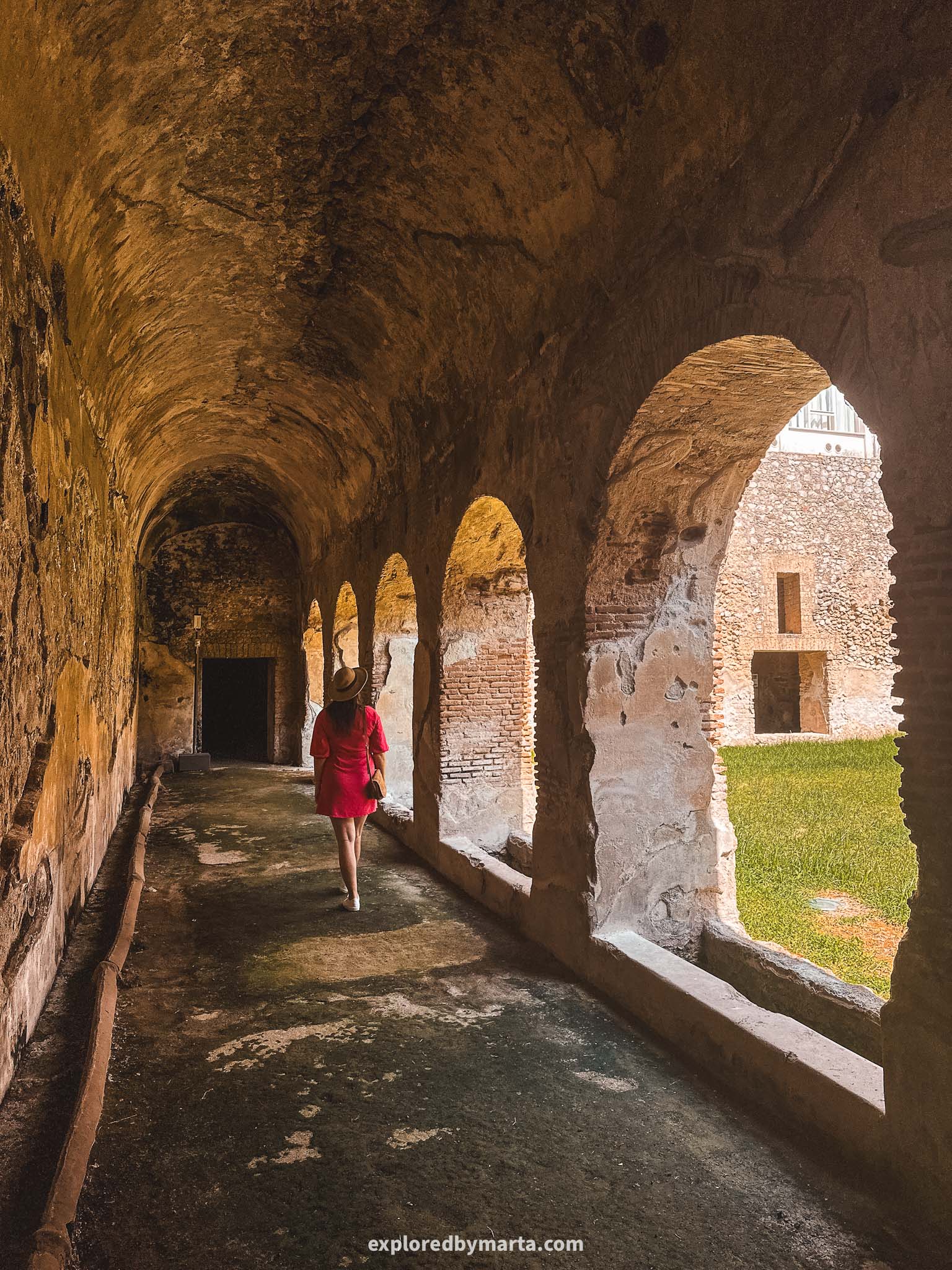
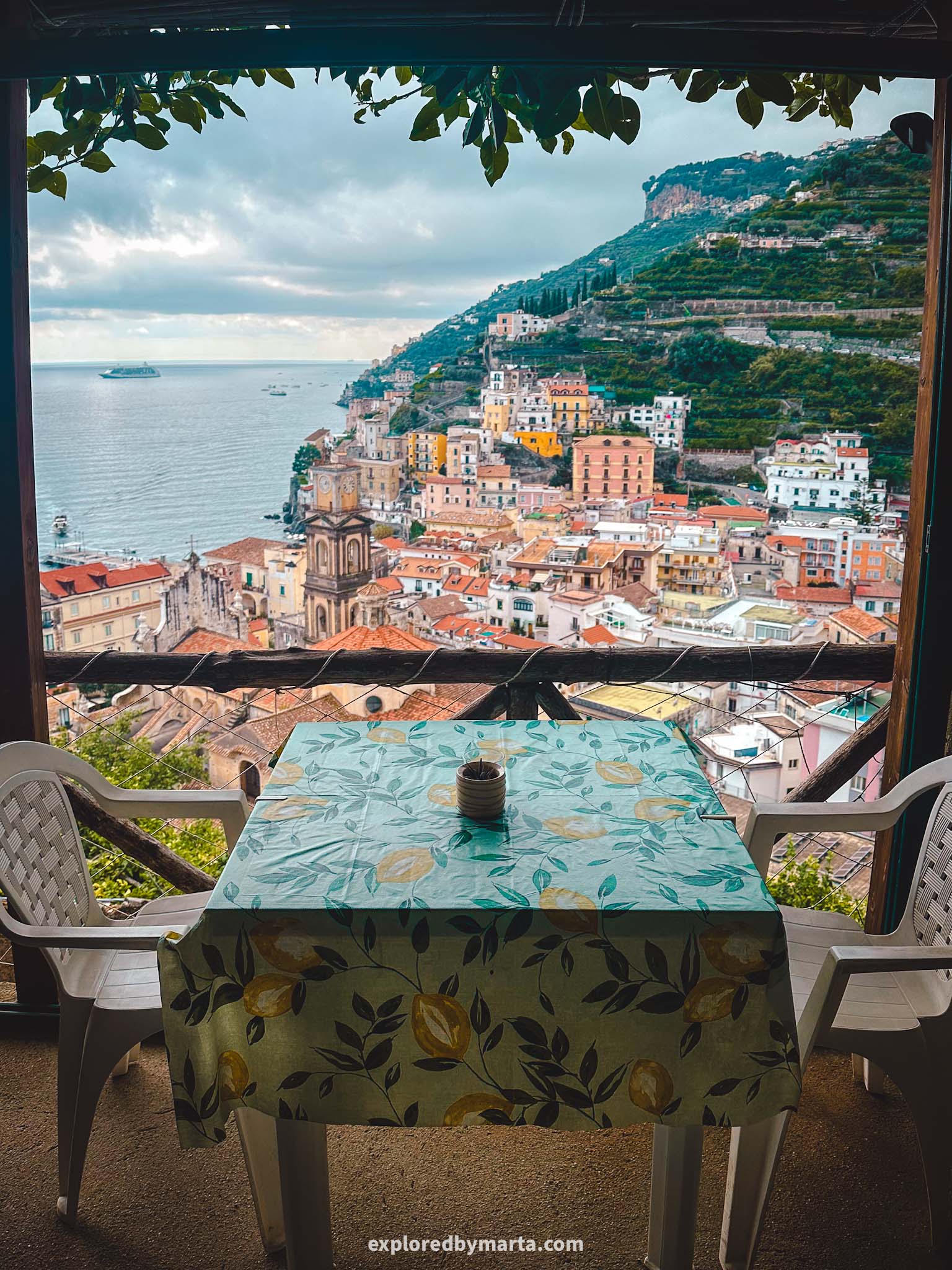
Minori is also the starting (or ending) point for the Path of the Lemons, a scenic hike that winds through lemon groves between Minori and Maiori.
We actually started the hike in Maiori, came to Minori, had a dessert in Pasticceria Sal De Riso, and then went back along the coastal road.
Because of its size, Minori is easy to explore in a day, but it also makes a wonderful base for a longer stay. If you’re dreaming of the Amalfi Coast without the hustle, then look no further – Minori is the perfect match for you!
Location: Minori
9. Cetara, home of the famous colatura di alici
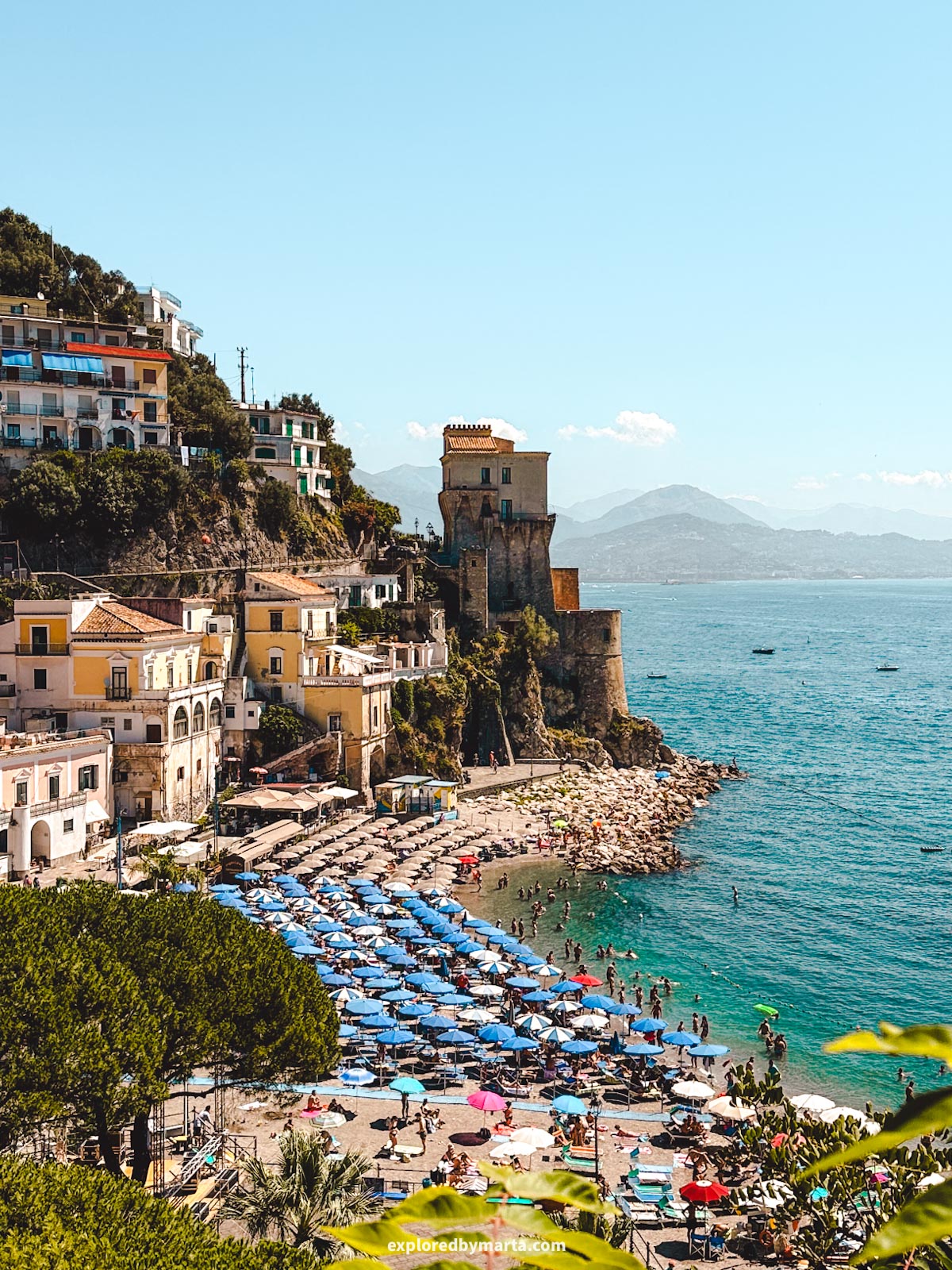
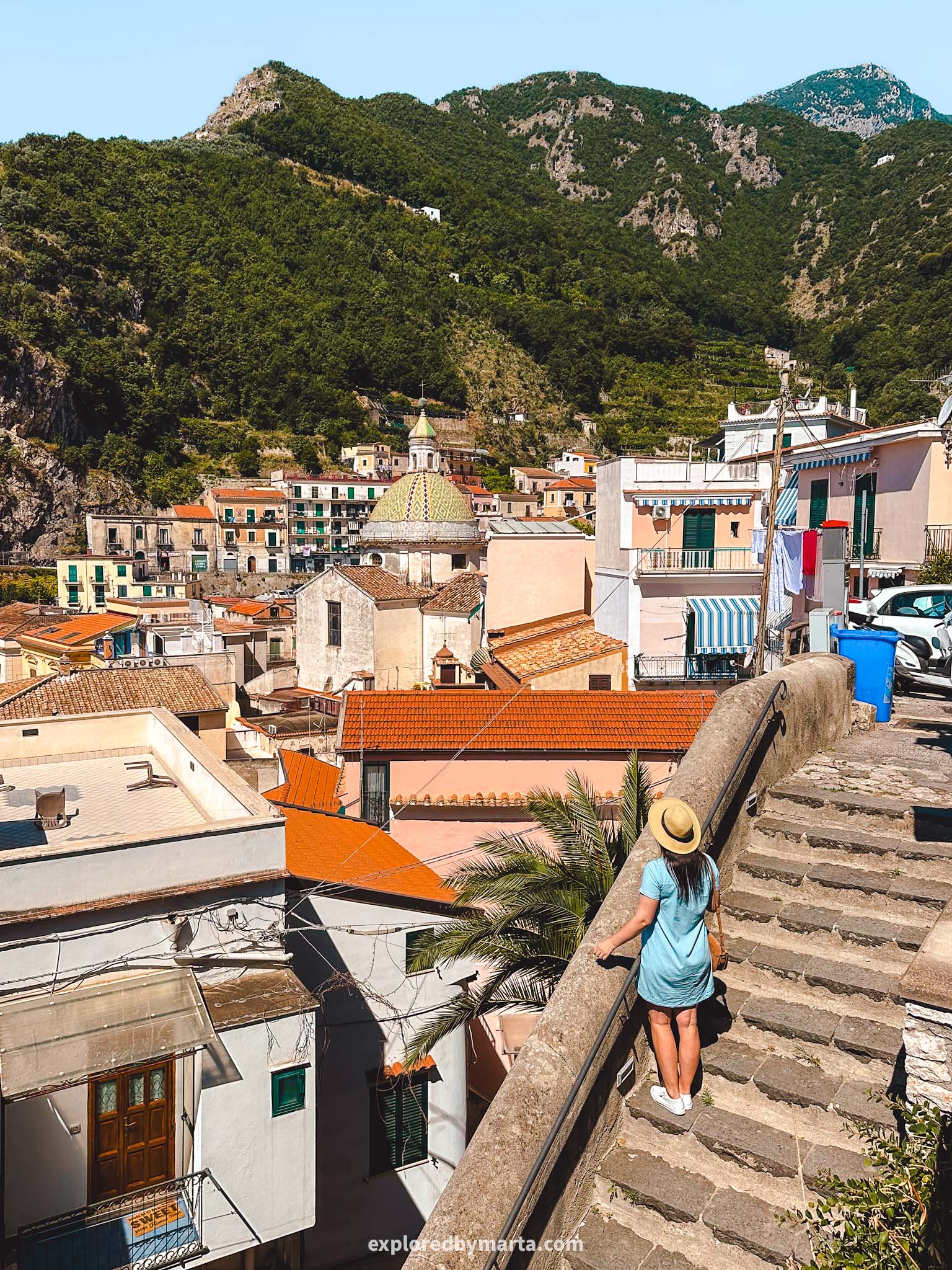
Cetara is one of the Amalfi Coast’s best-kept secrets. Tucked between steep cliffs and the sea, this ancient fishing village is one of the most authentic places you will find on the Amalfi Coast.
Cetara is best known for its anchovies. The town has a centuries-old tradition of fishing and preserving them, producing a local delicacy called colatura di alici – an anchovy-based fish sauce that dates back to Roman times.
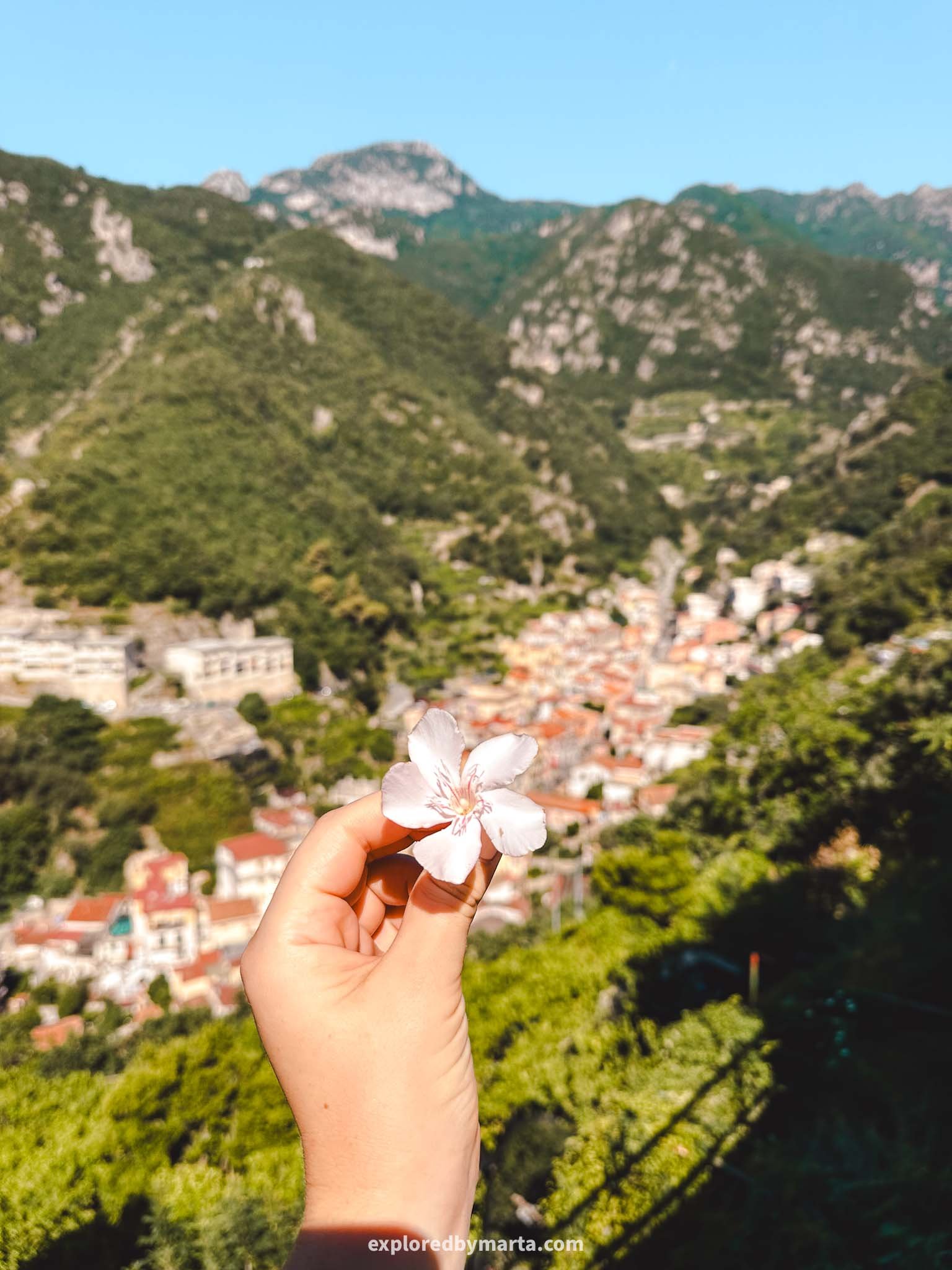

You can buy this famous fish sauce in many stores in Cetara, but you can also find a restaurant and order some food with this sauce. But, hey, it really is salty! I warned you! I actually much preferred their tuna fishing industry and bought a jar of locally-caught tuna to take home.
Cetara charms with its narrow alleys, colorful houses, and a small beach nestled beneath the cliffs. I especially loved the Church of San Pietro Apostolo, with its green-and-yellow tiled dome. However, there is one building that stands out here – the Tower of Cetara.
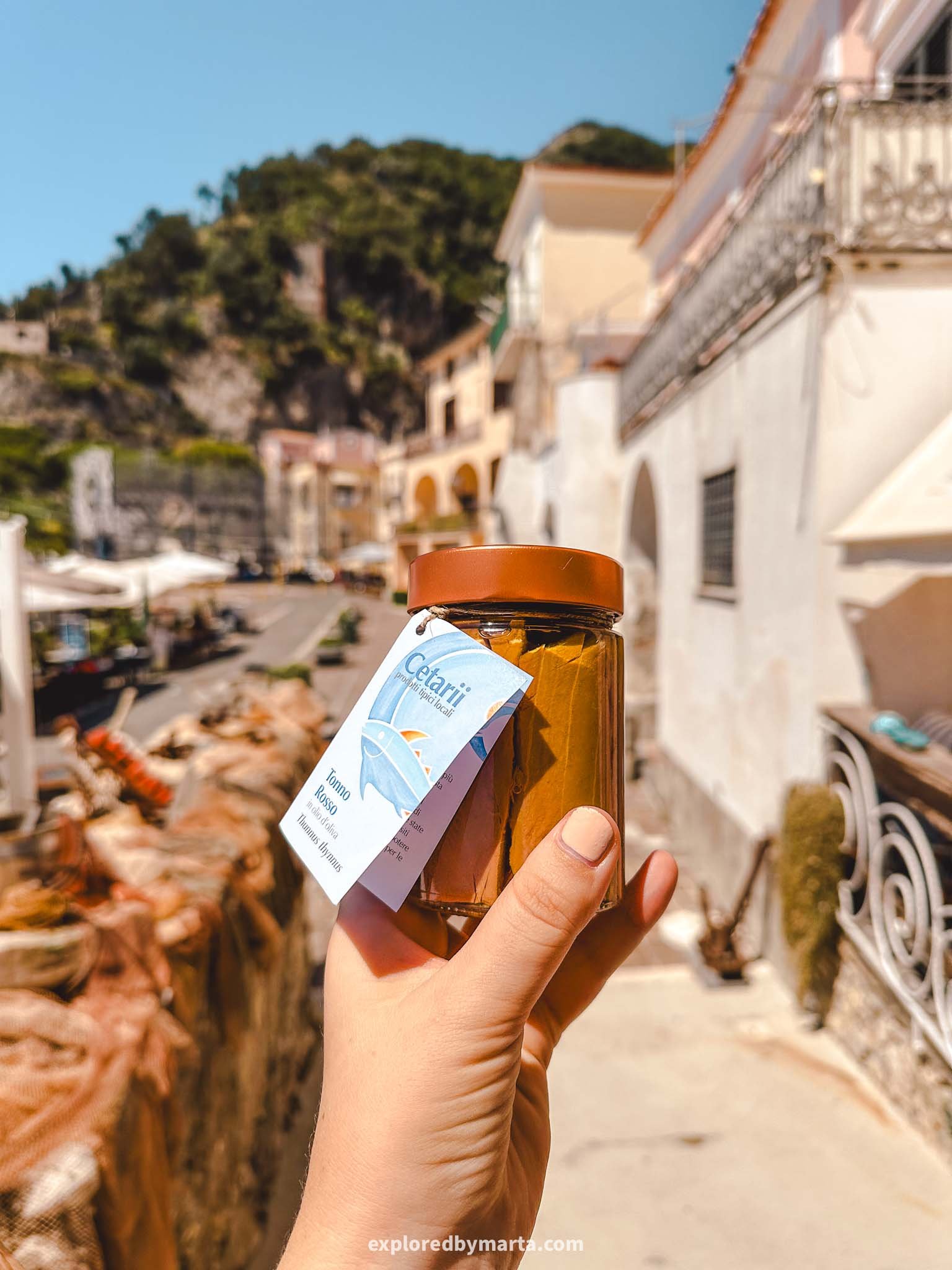
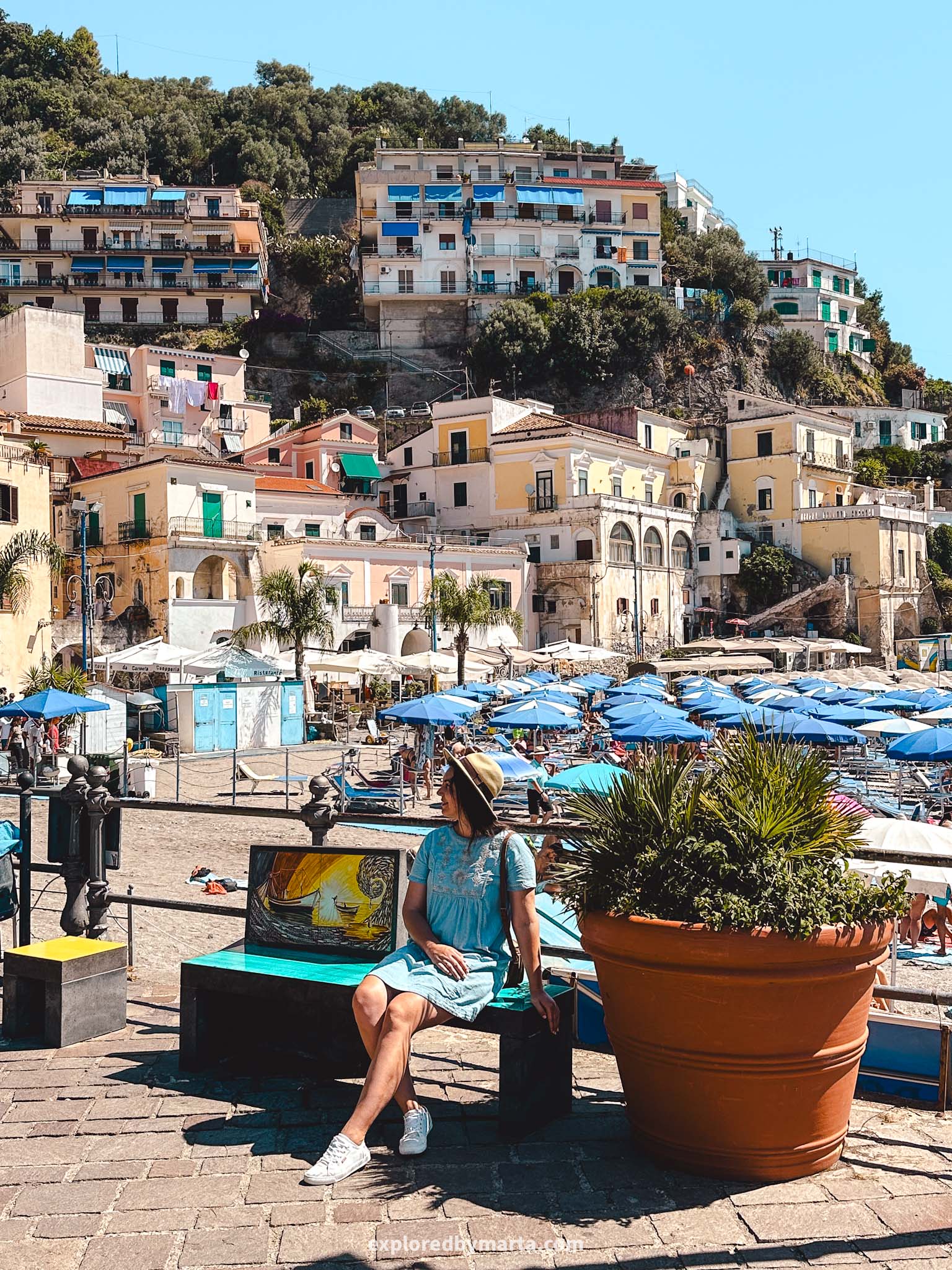
Torre di Cetara, or the Tower of Cetara, is the symbol of this little seaside village, and it is the first thing you’ll notice after arriving here.
After experiencing many pirate attacks, a whole network of defense watchtowers were built along the Amalfi Coast back in the 16th century. One of them still stands here, looming over the main beach of Cetara.

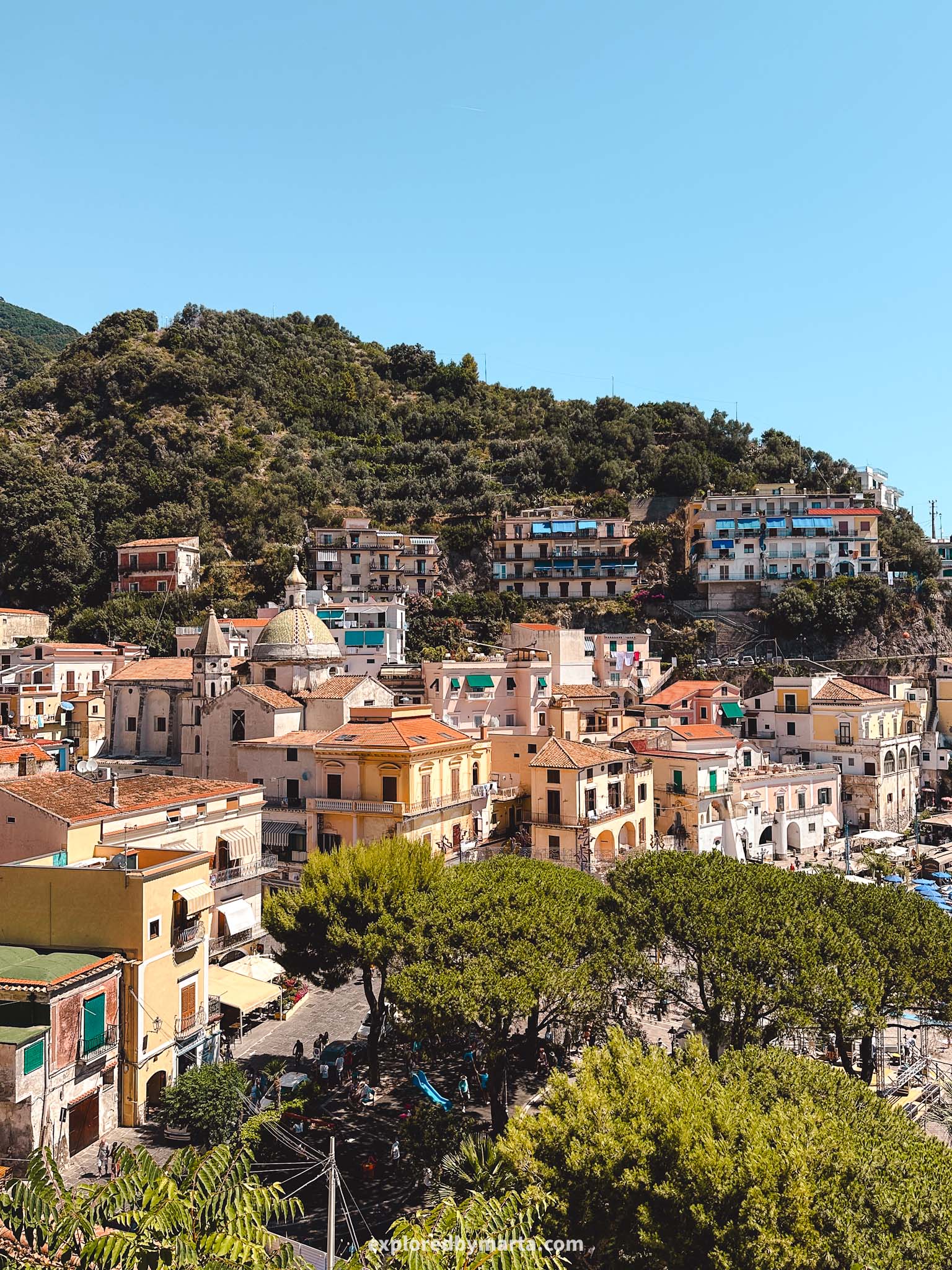
One of the best things about Cetara is how peaceful and authentic it feels. Not many tourists can squeeze one more village in their already-busy travel itineraries, but I’m glad we got to visit this place!
Cetara is easy to reach by bus or ferry from Salerno and Vietri sul Mare, making it a perfect stop for a short visit. If you’re a food lover, Cetara is worth a visit for the colatura di alici alone.
Location: Cetara
10. Furore, the hidden fjord of the Amalfi Coast
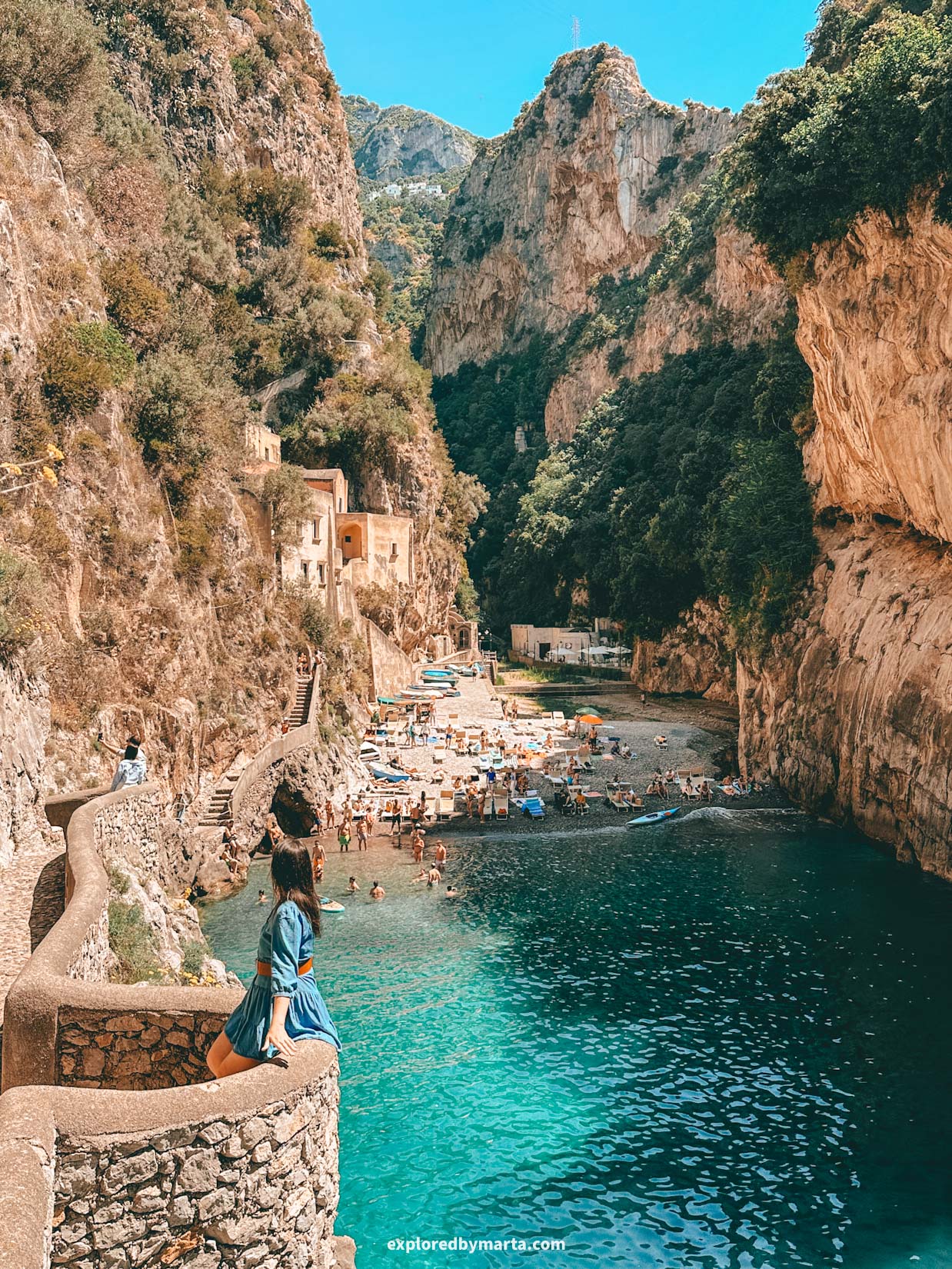
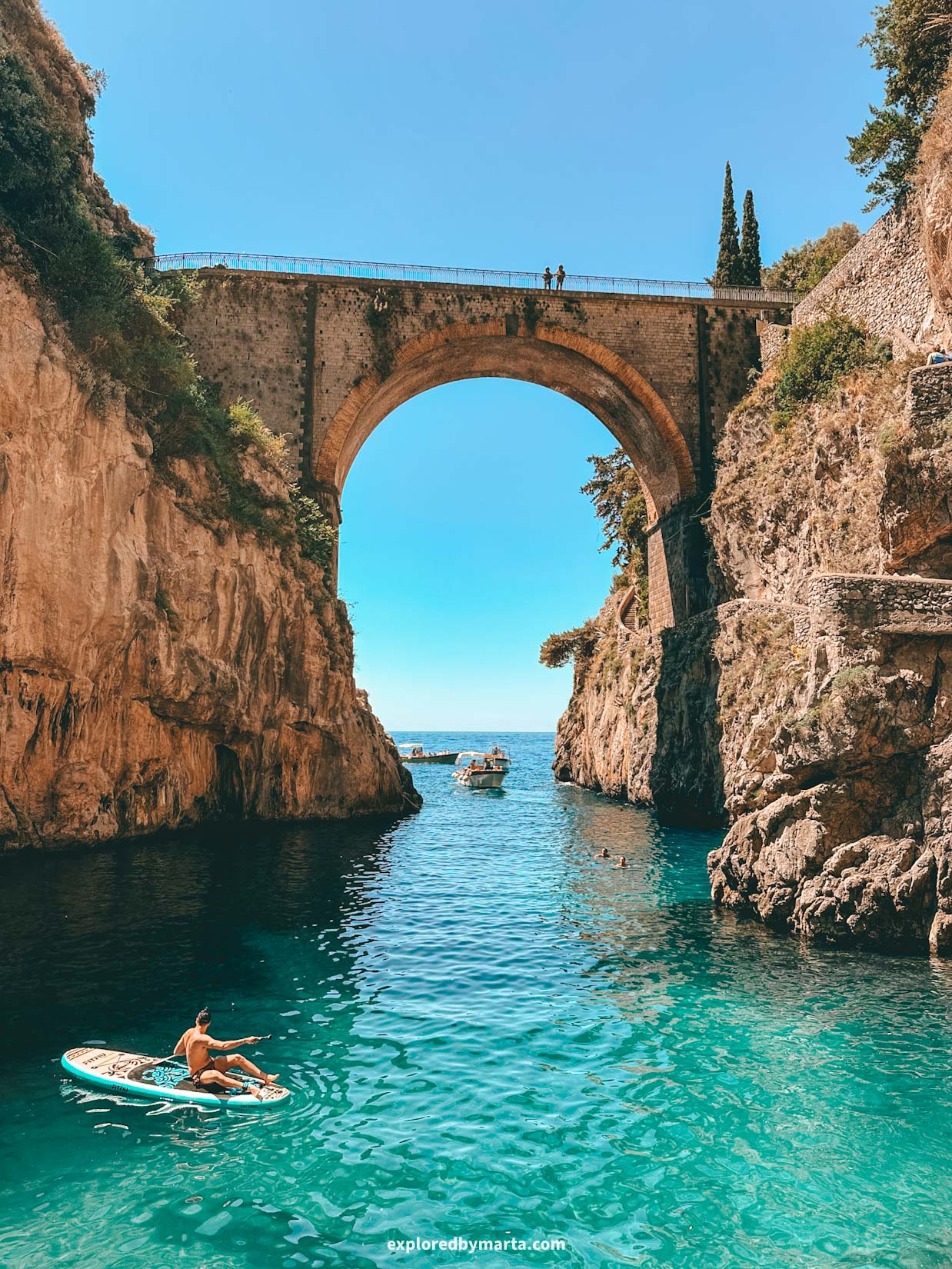
Unlike most villages on the Amalfi Coast, Furore doesn’t really have a center, or even much of a town at all. Instead, it’s scattered across the cliffs in a series of tiny hamlets and staircases. I actually didn’t even know that Furore was a village!
But Furore does have one thing, and it is one of the most photographed spots on the coast: the Fiordo di Furore.
I’m sure you’ve seen this deep and narrow cove all over the internet – it is one of the most famous spots and one of the most beautiful places on the Amalfi Coast.
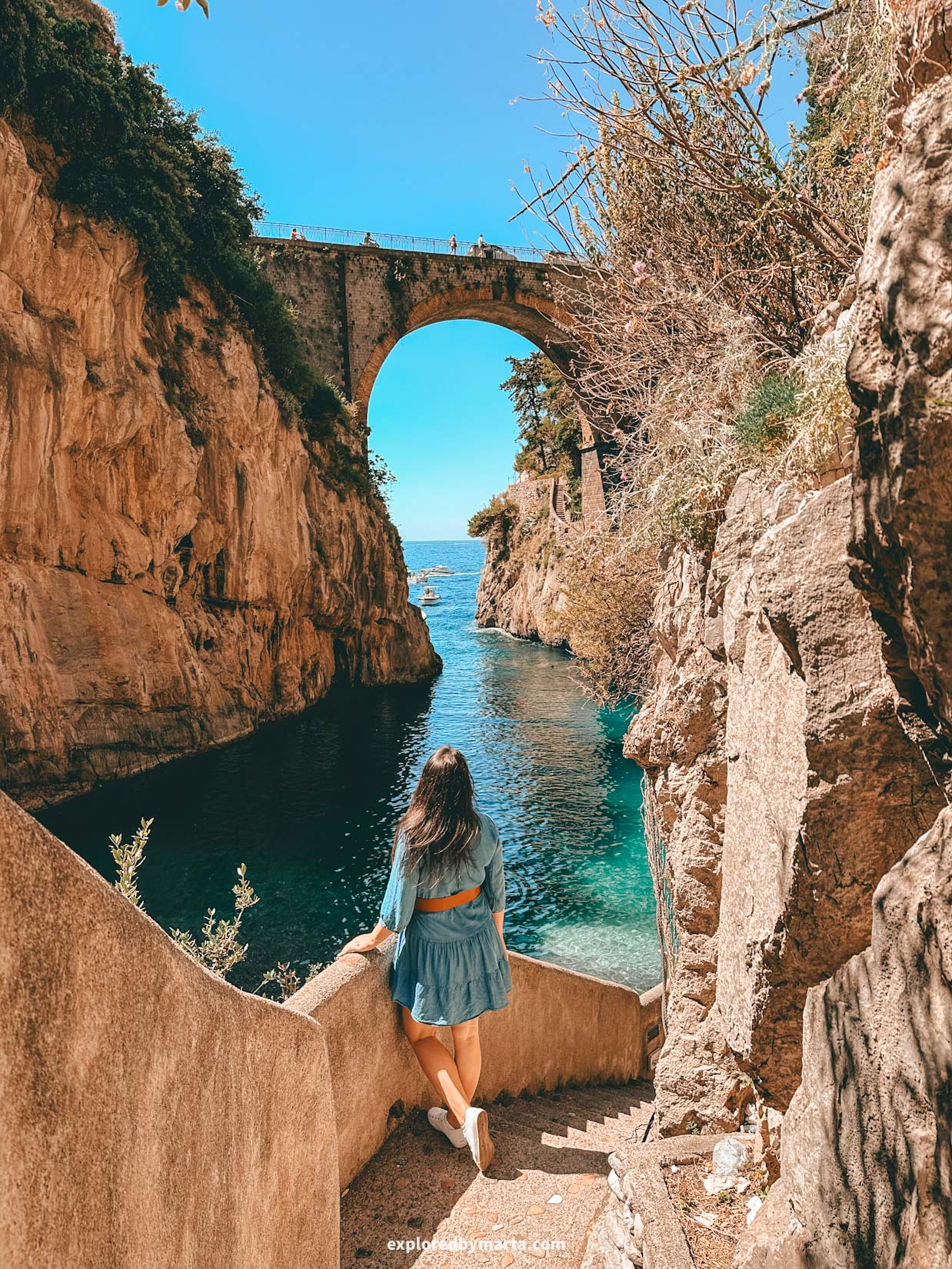
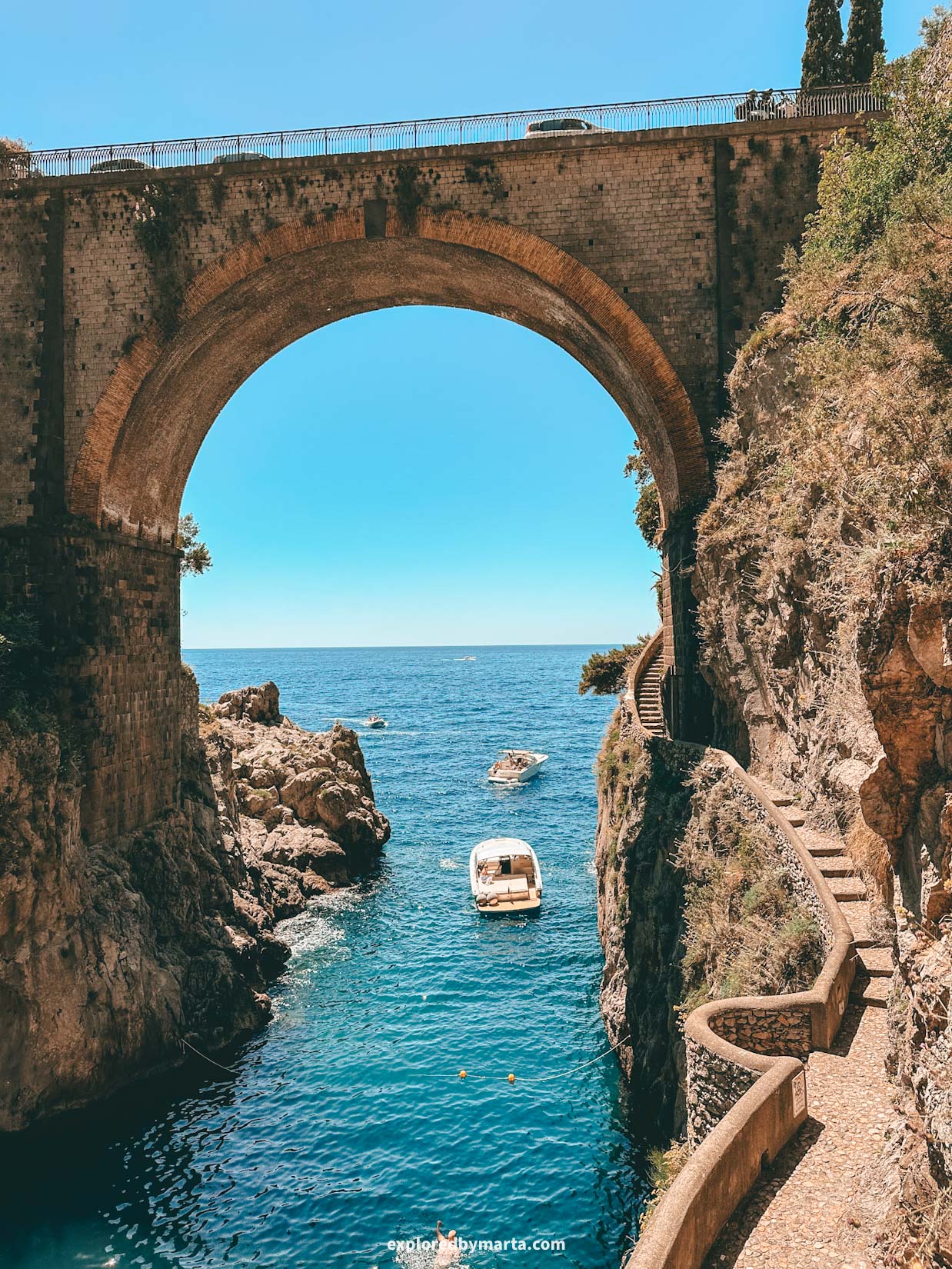
Despite its name (fiordo=fjord), technically it is not a fjord, because fjords are formed by glaciers, but this fjord-like gorge was formed by a river. Nevertheless, this place is pure beauty!
Thanks to its dramatic cliffs, 30-meter arched bridge, fishermen’s houses built inside the rock, and pristine waters washing the tiny pebble beach, Fiordo di Furore has become a landmark place to visit on the Amalfi Coast.
If you’re staying nearby in Amalfi, Positano, or Praiano, Furore makes for a great day trip! The easiest way to get to Fiordo di Furore is by SITA SUD public bus – there is a bus stop right on top of the bridge. Then just follow a steep, narrow stairway down to the beach.
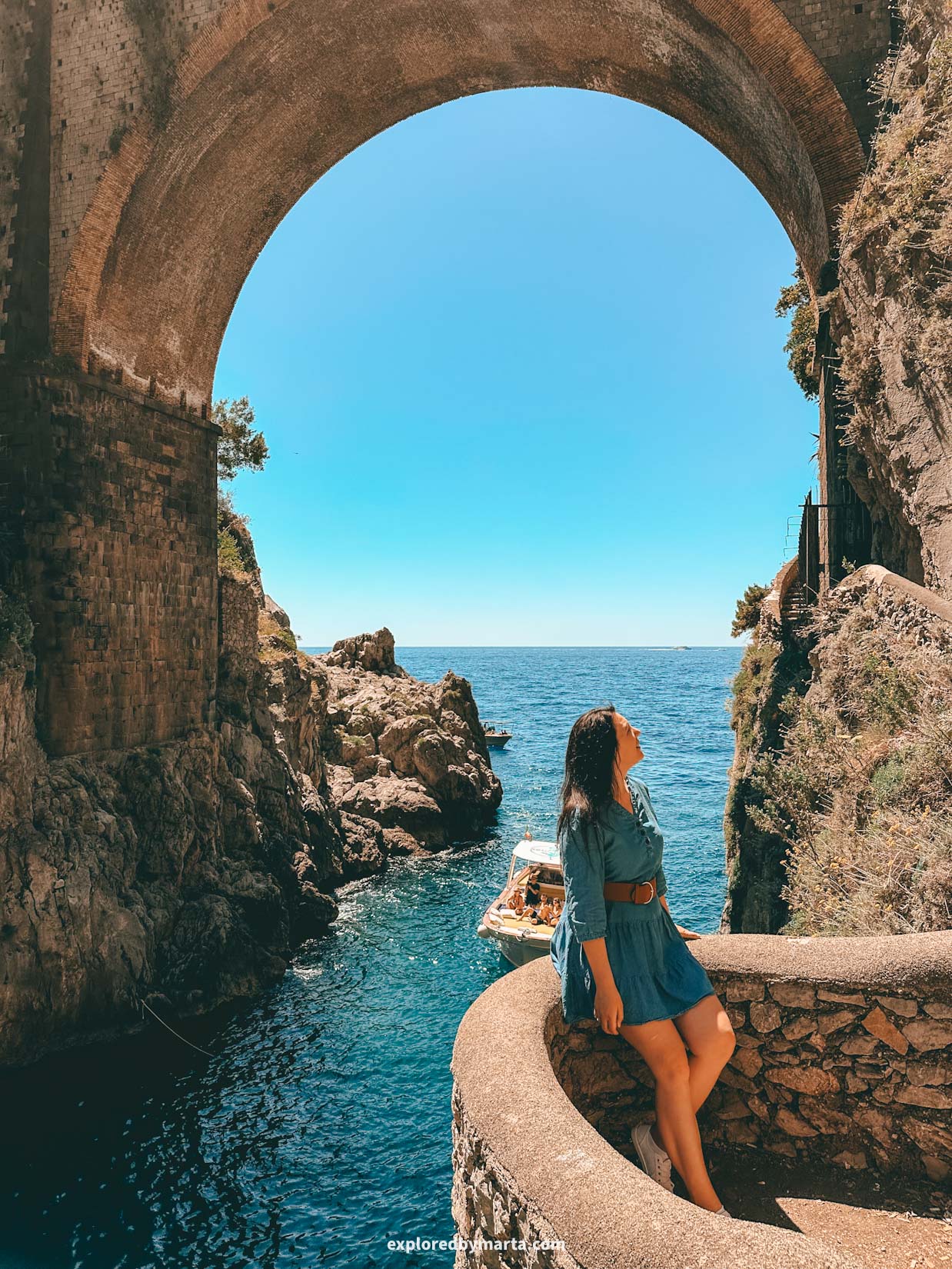
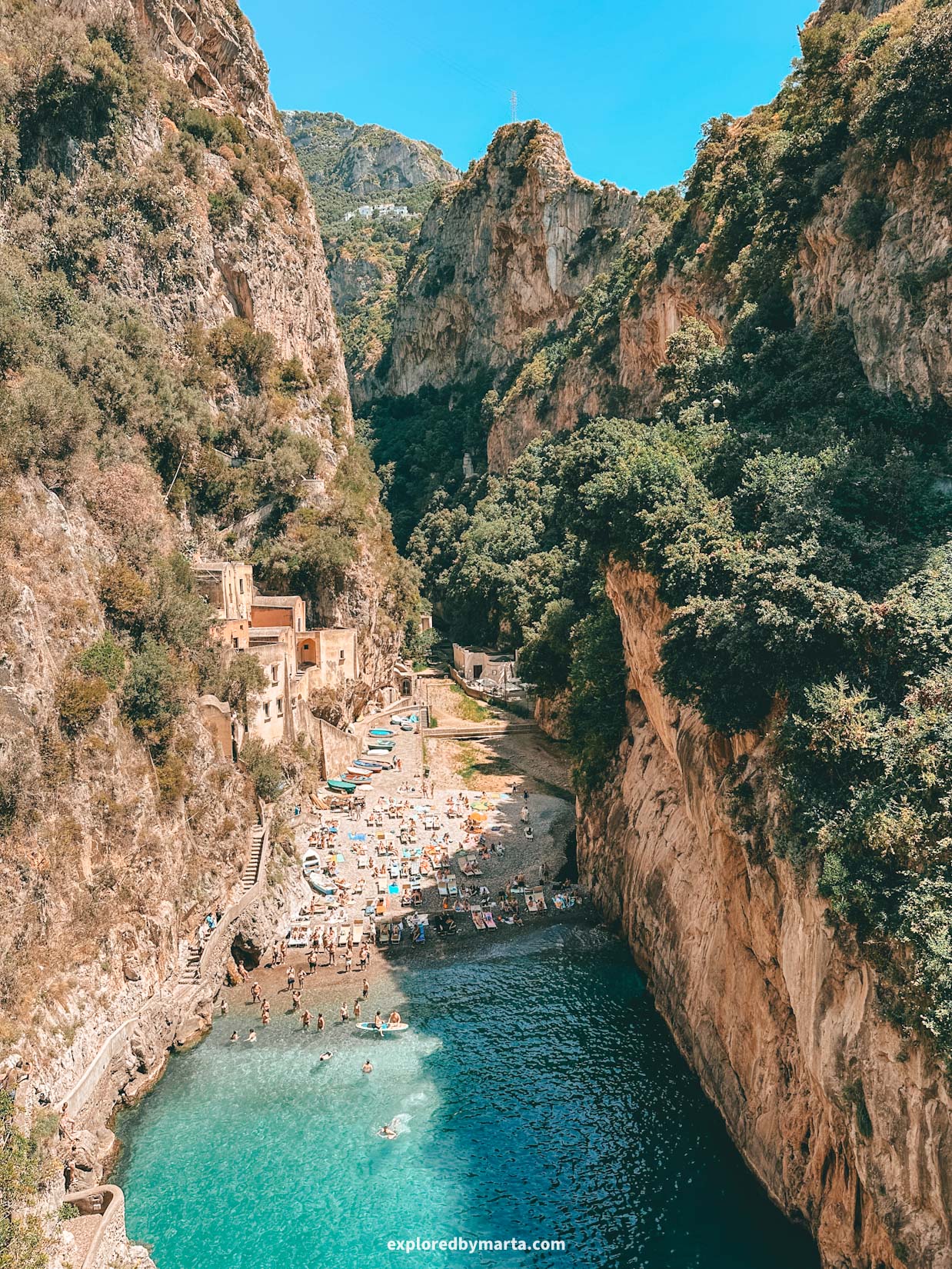
We had a car, so we drove to Marina di Praia, parked our car there, and then walked all the way to Fiordo di Furore (it’s a 10-15 minute walk). If you rent a scooter, you will definitely find some parking spots along the road, much closer to the fjord.
Because of its surrounding rugged cliffs, the sun only shines inside the fjord for a couple of hours during the day, so this place has a pleasant microclimate and offers nice shade during the summer heat!
Whether you visit Fiordo di Furore to spend the day by the beach or just come to check out its picturesque location and take some iconic photos, you will definitely be impressed by how beautiful this unique place is.
Location: Fiordo di Furore
Happy exploring!
The Amalfi Coast, a UNESCO World Heritage Site, is known for its natural beauty, scenic views, and beautiful architecture. I haven’t been everywhere, but it has to be one of the most picturesque spots on our planet!
We spent half a year living in and exploring the area on and around the Amalfi Coast. It’s easy to see why this region has drawn everyone from simple fishermen to Roman emperors to its shores for thousands of years.
I hope you find some travel inspiration in this Amalfi Coast guide, and that you enjoy your time on Italy’s Divine Coast as much as we did. The beaches, the views, the villages, the food… It’s a place you’ll never forget!
PIN FOR LATER!
